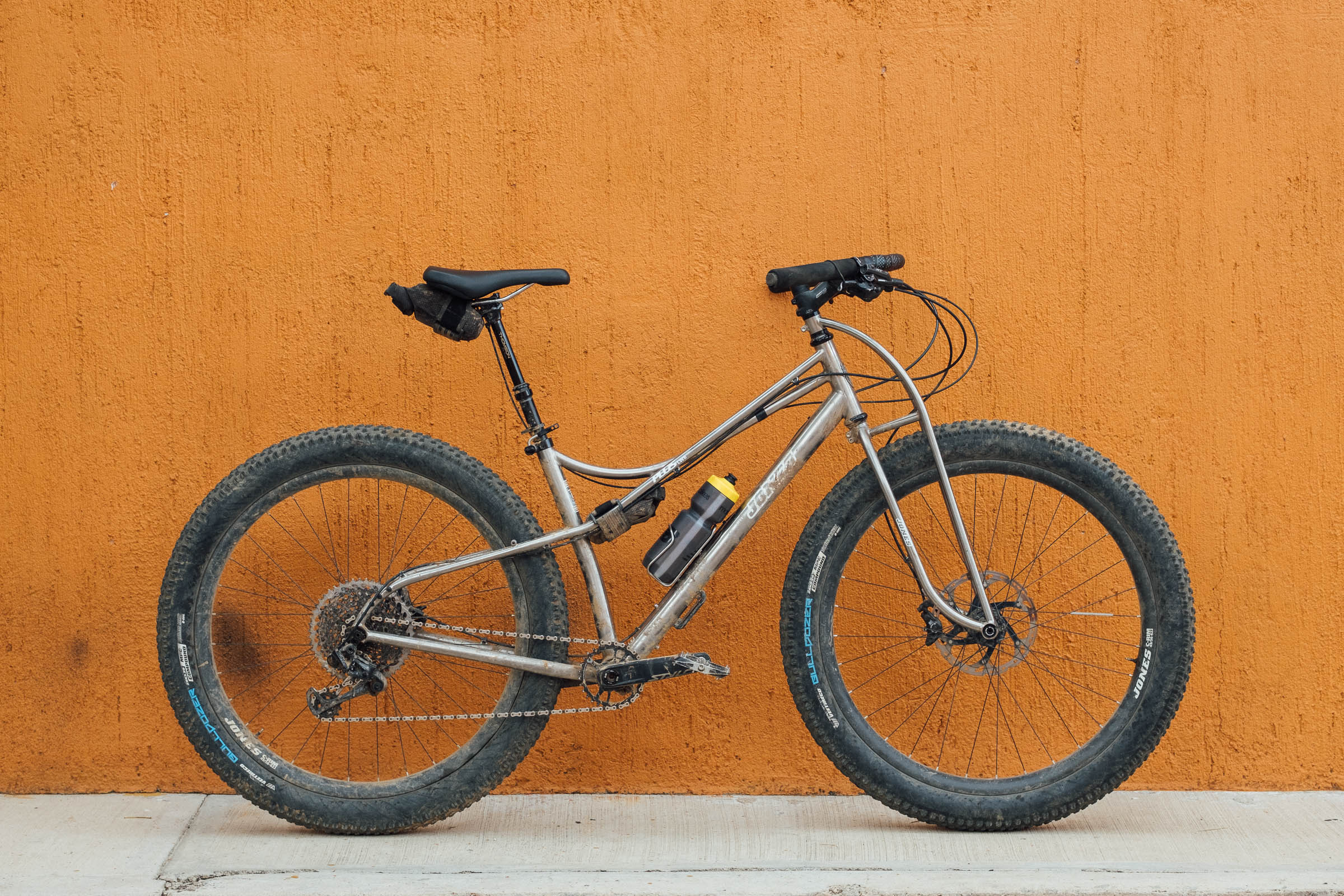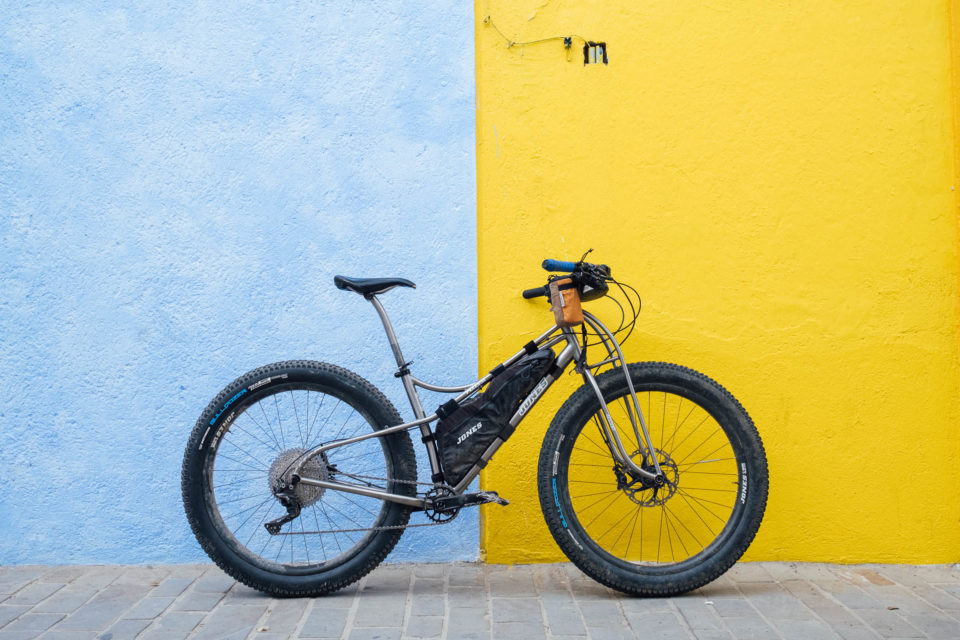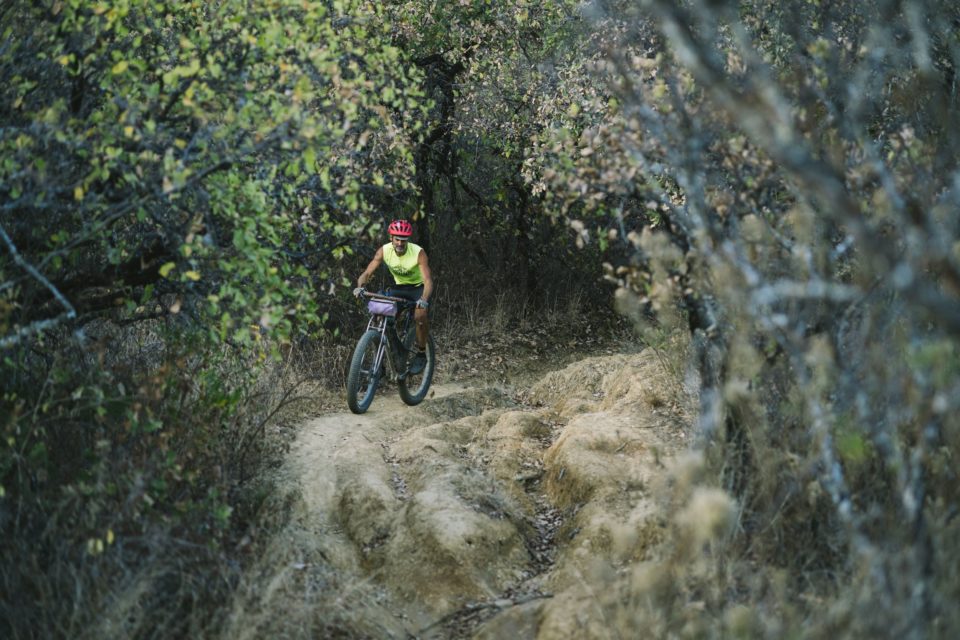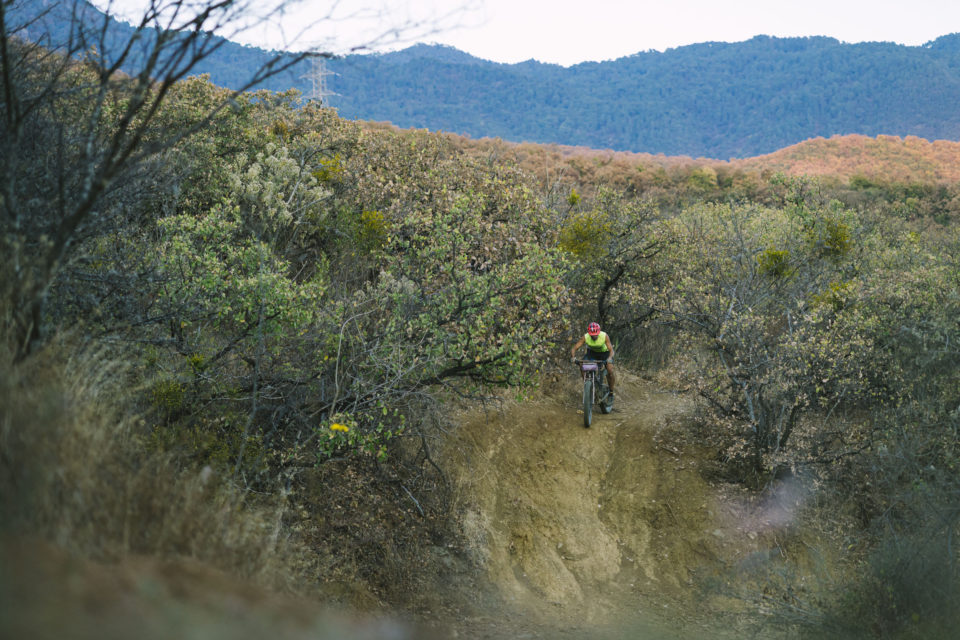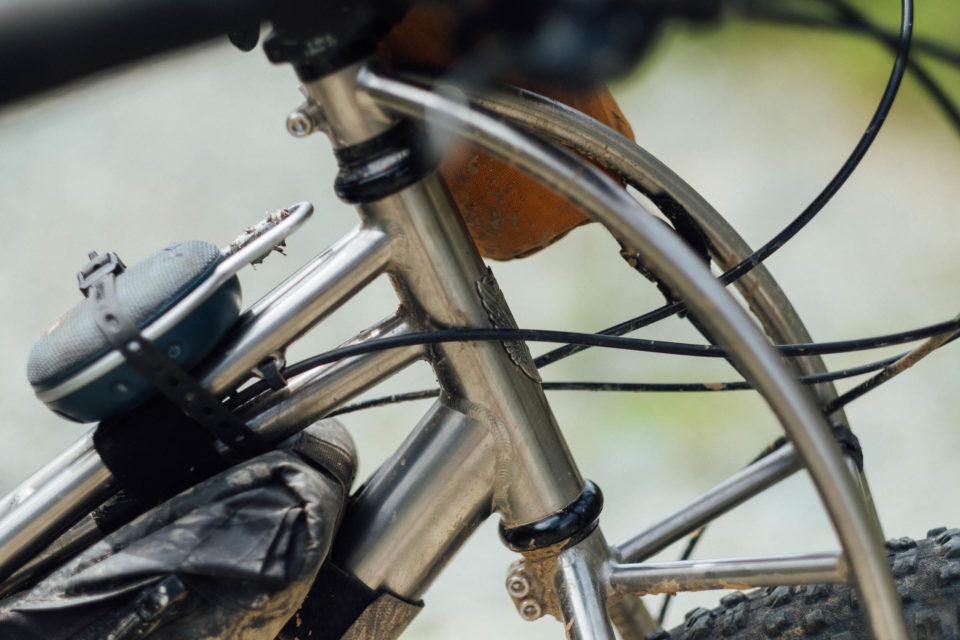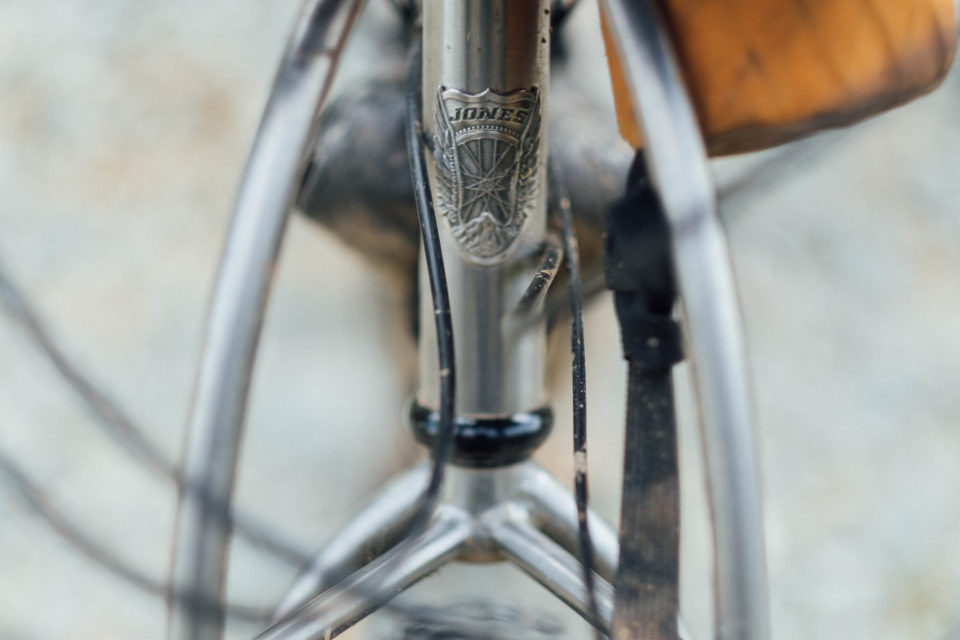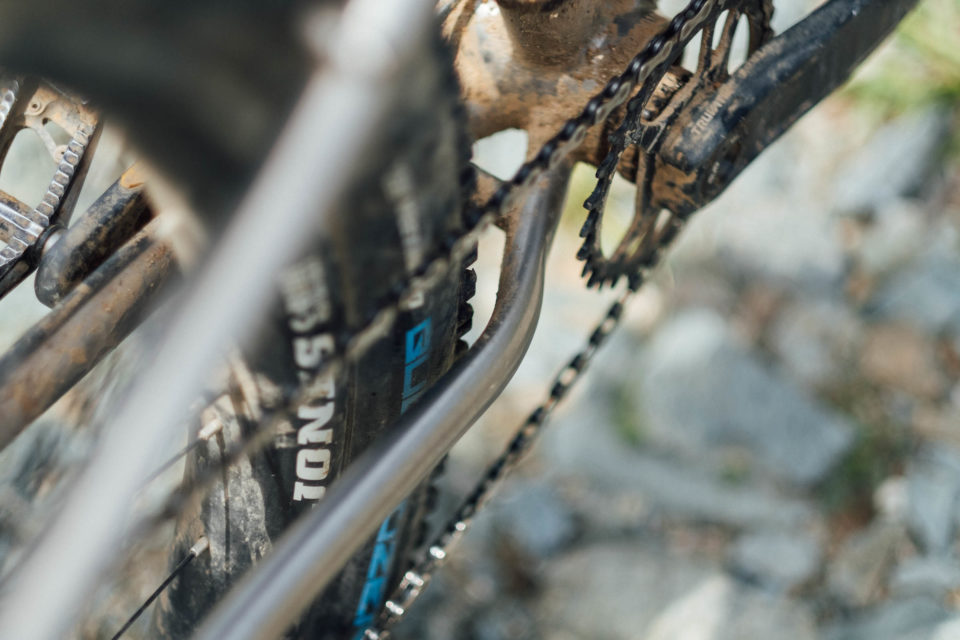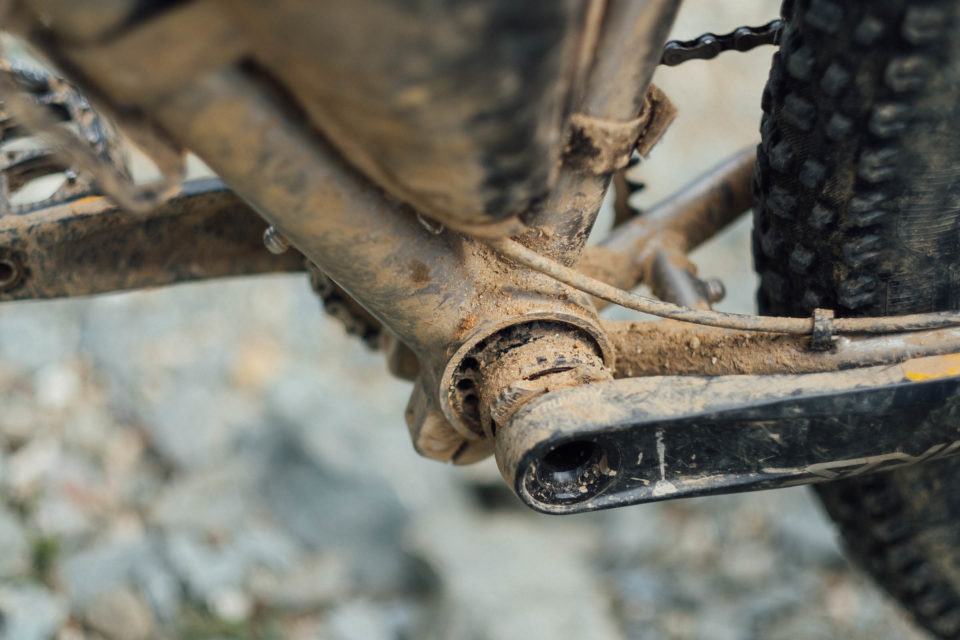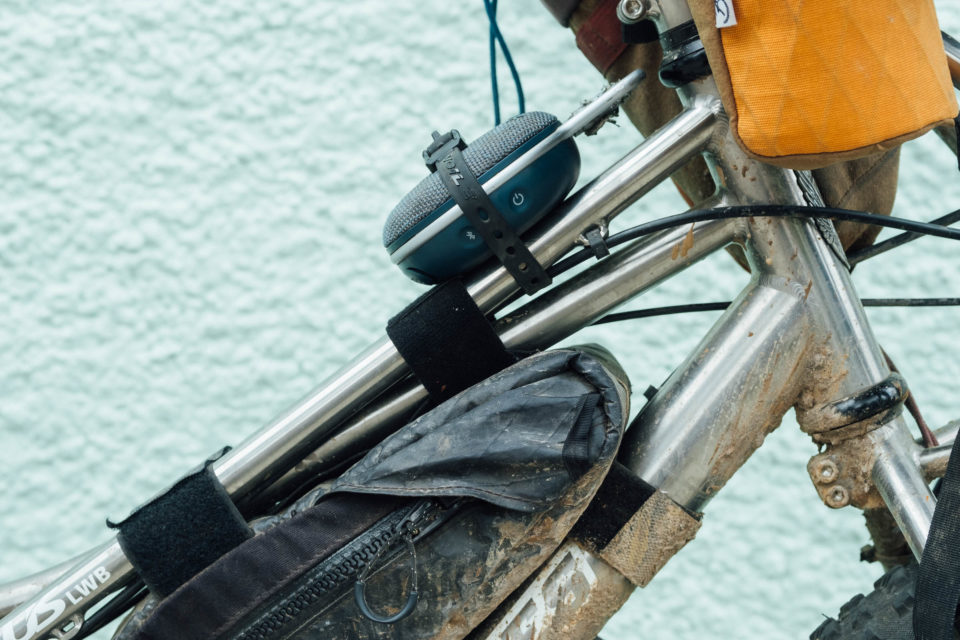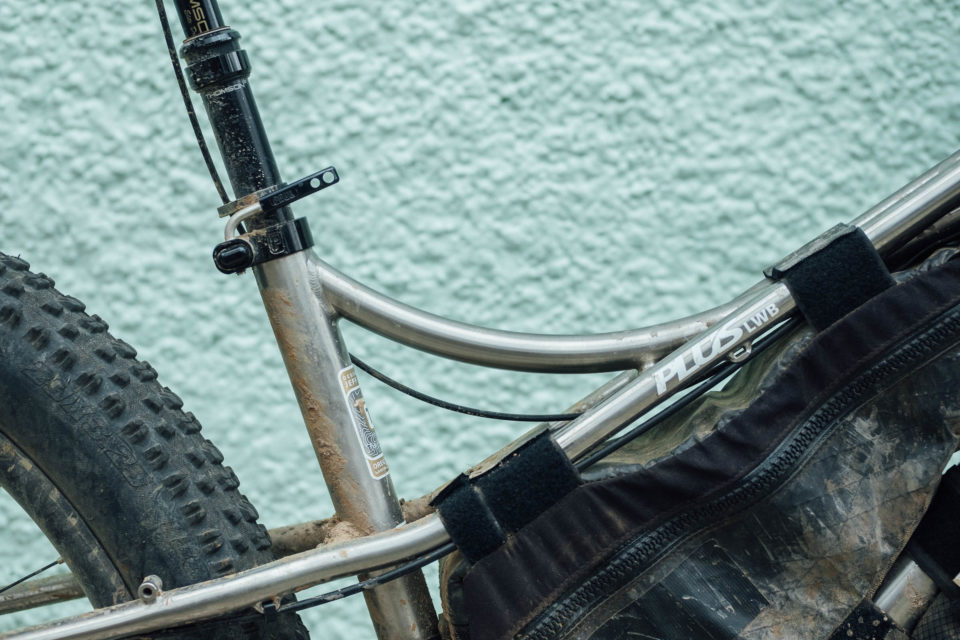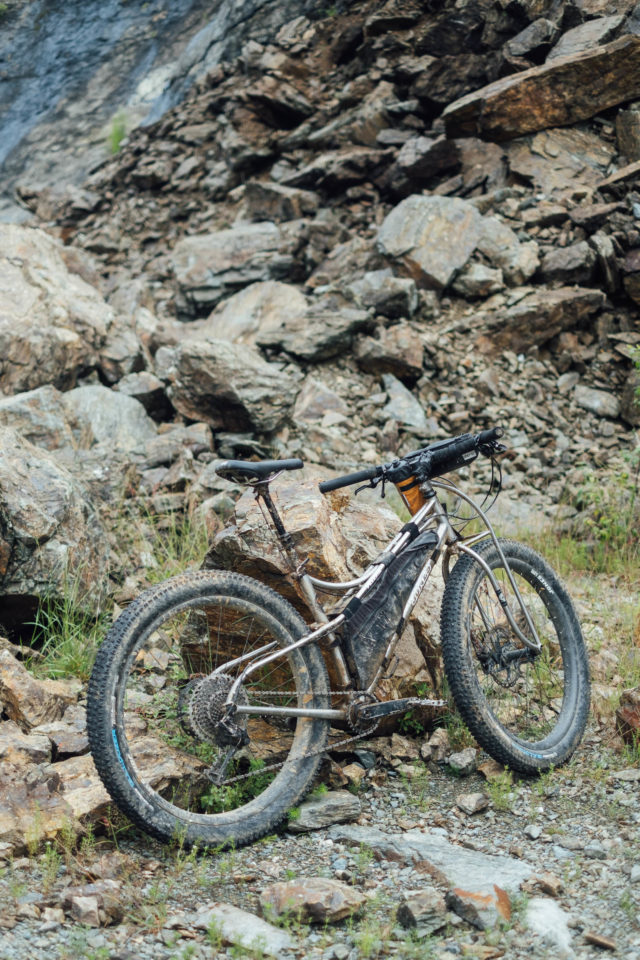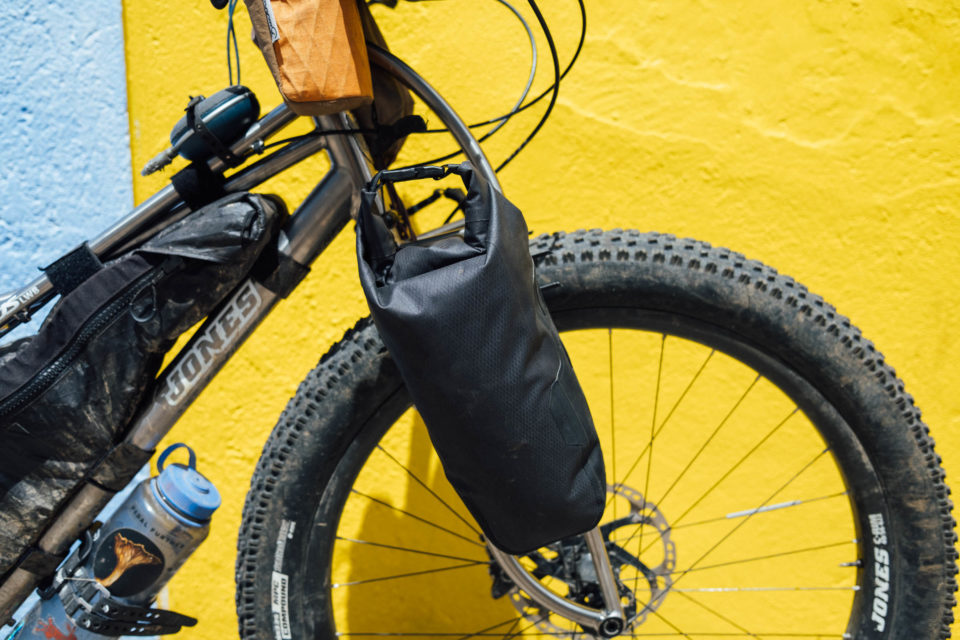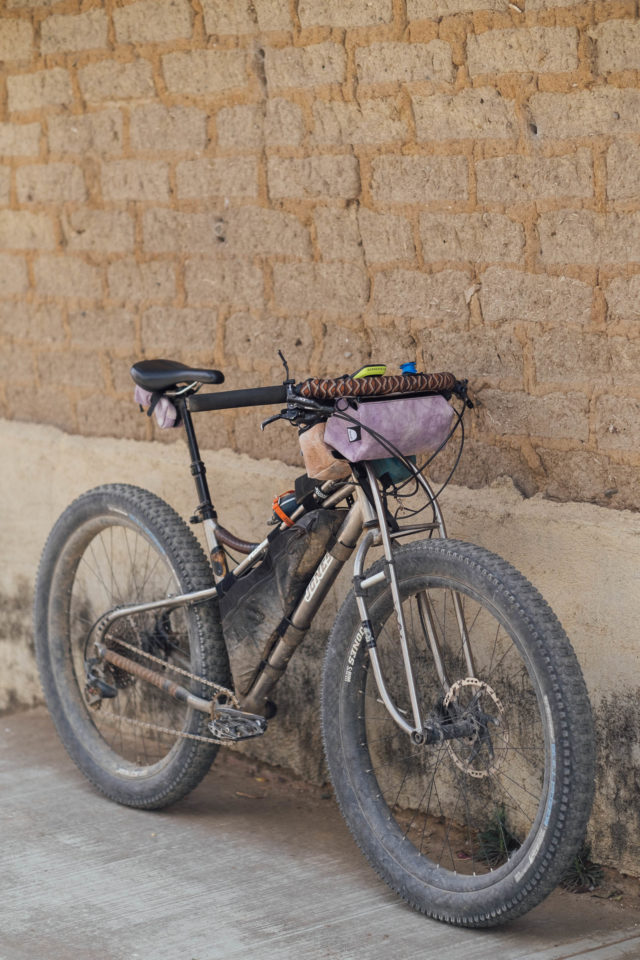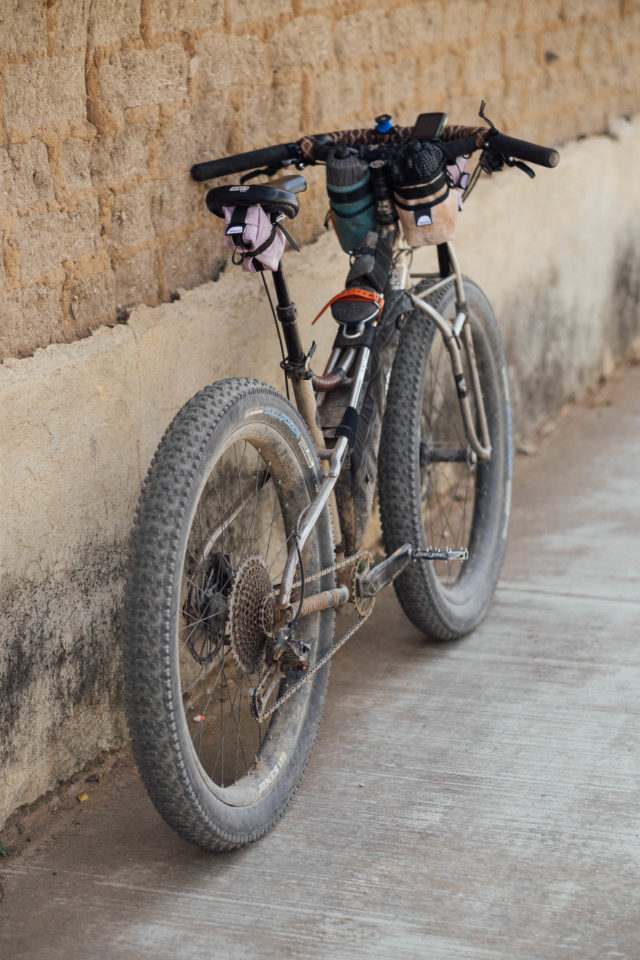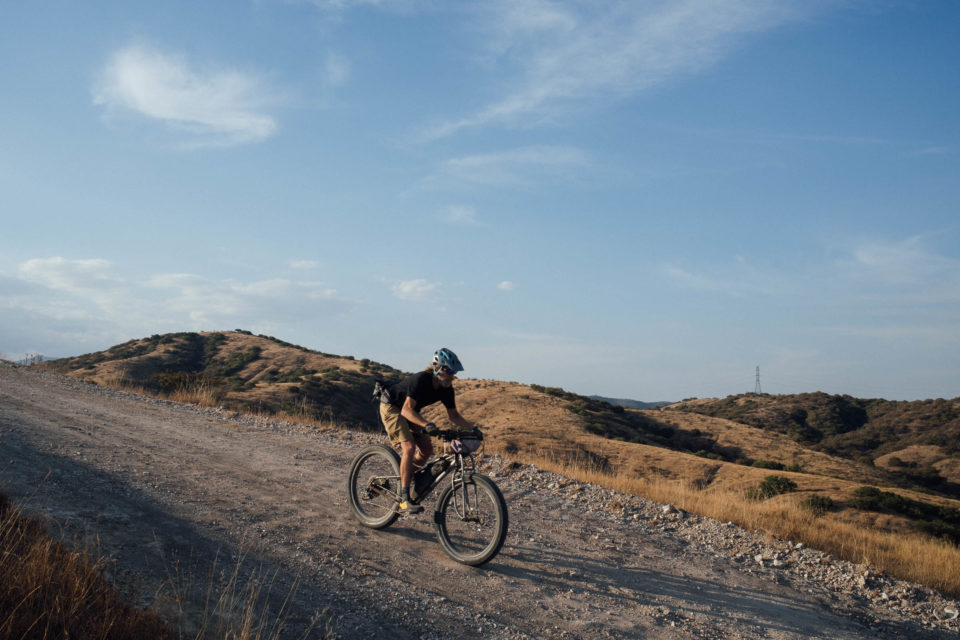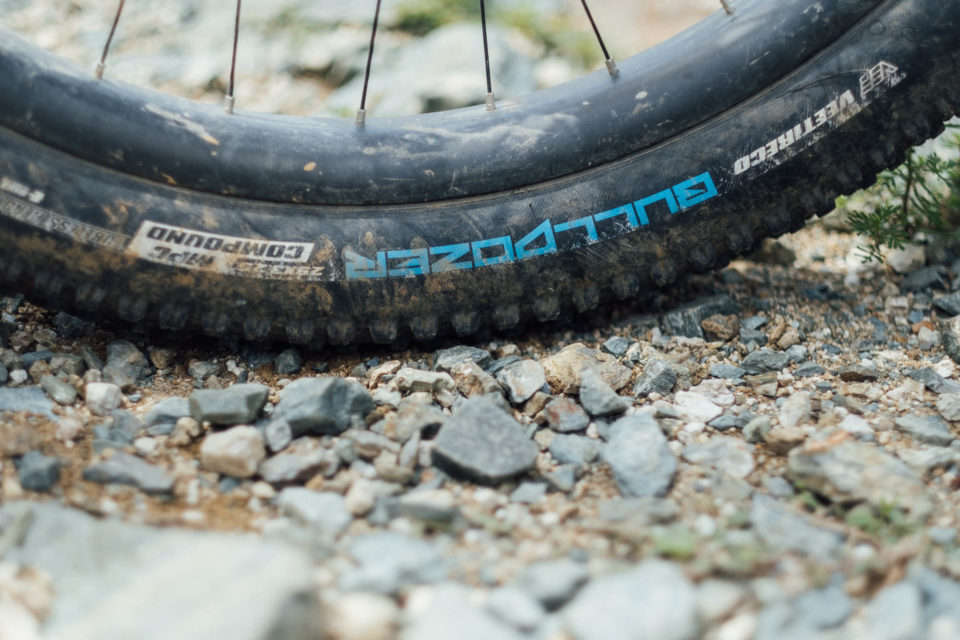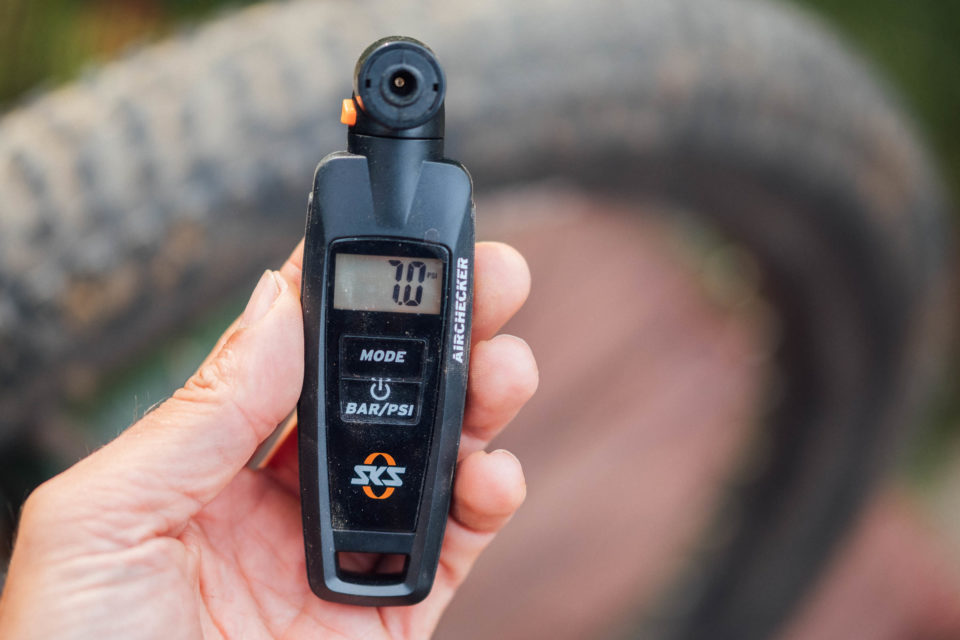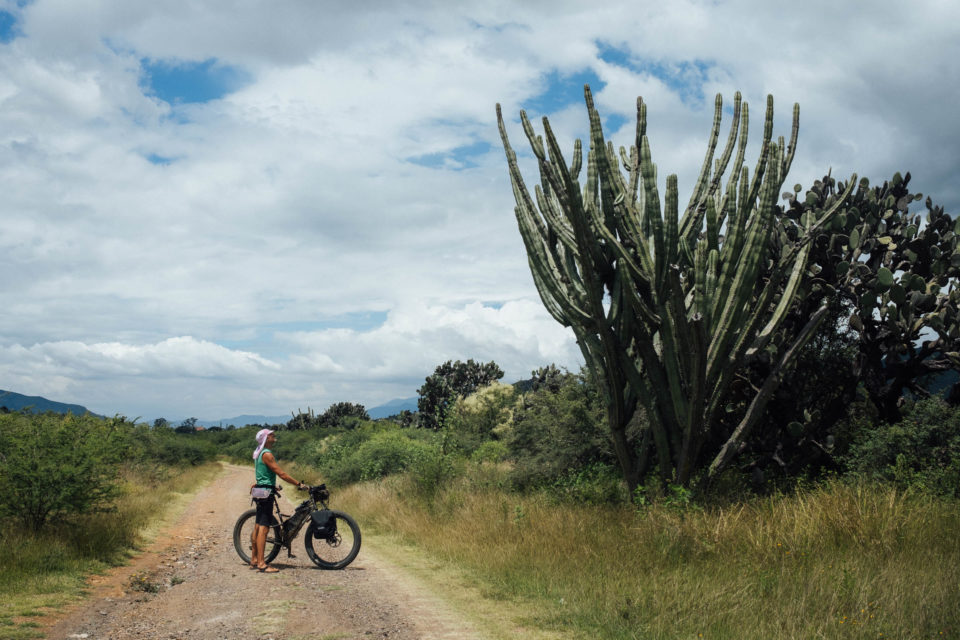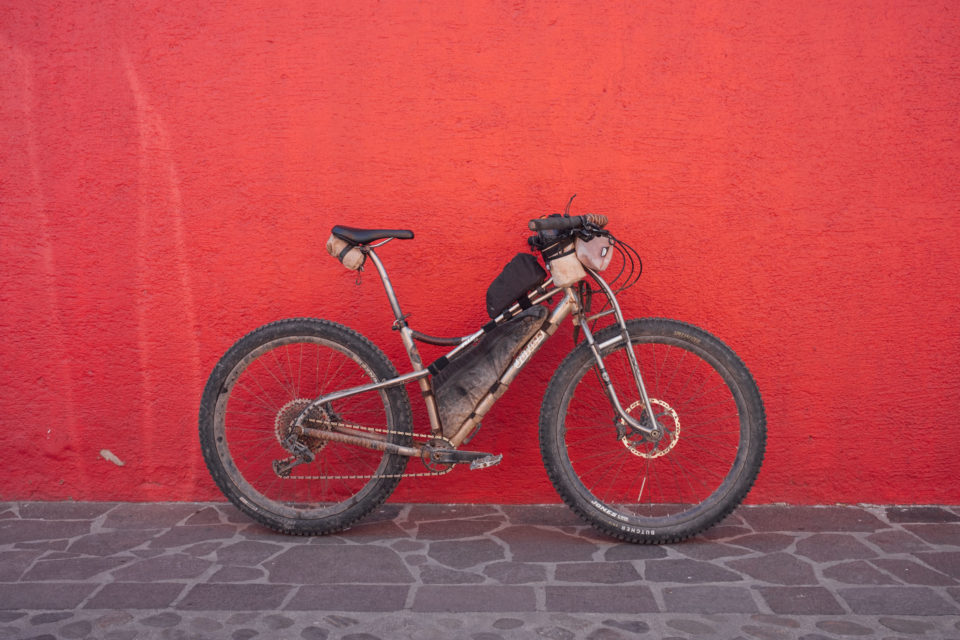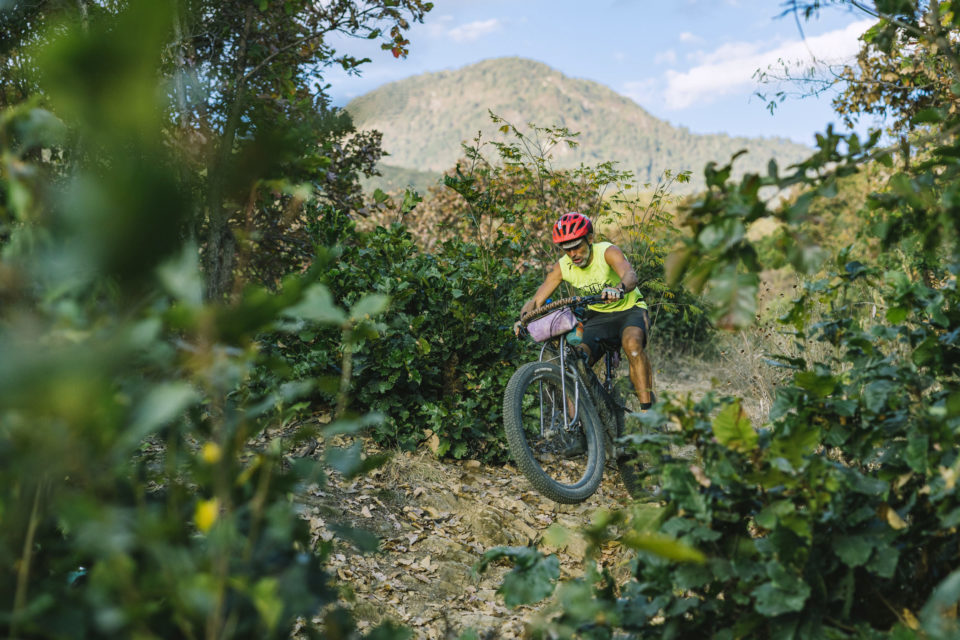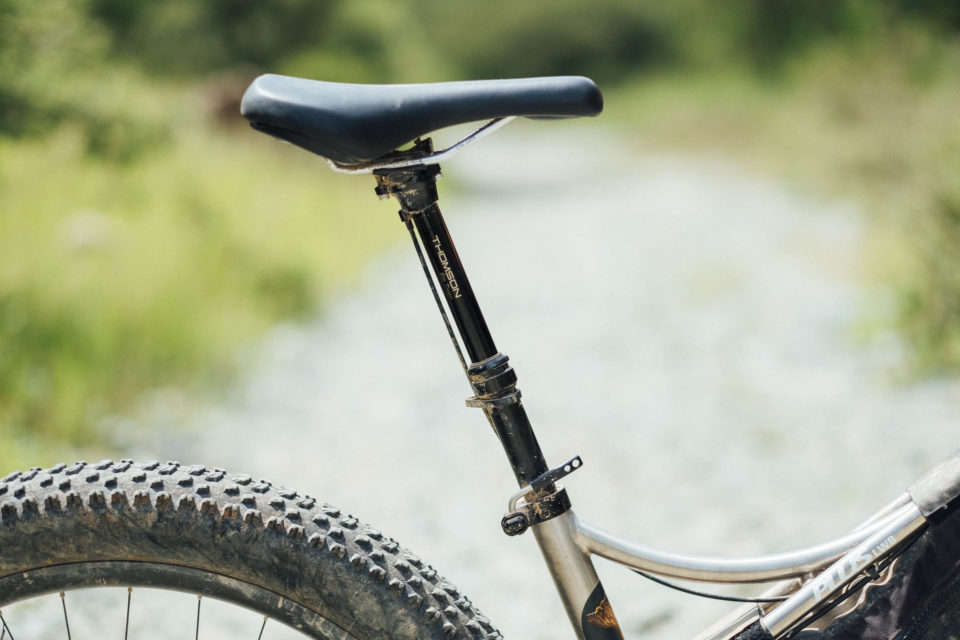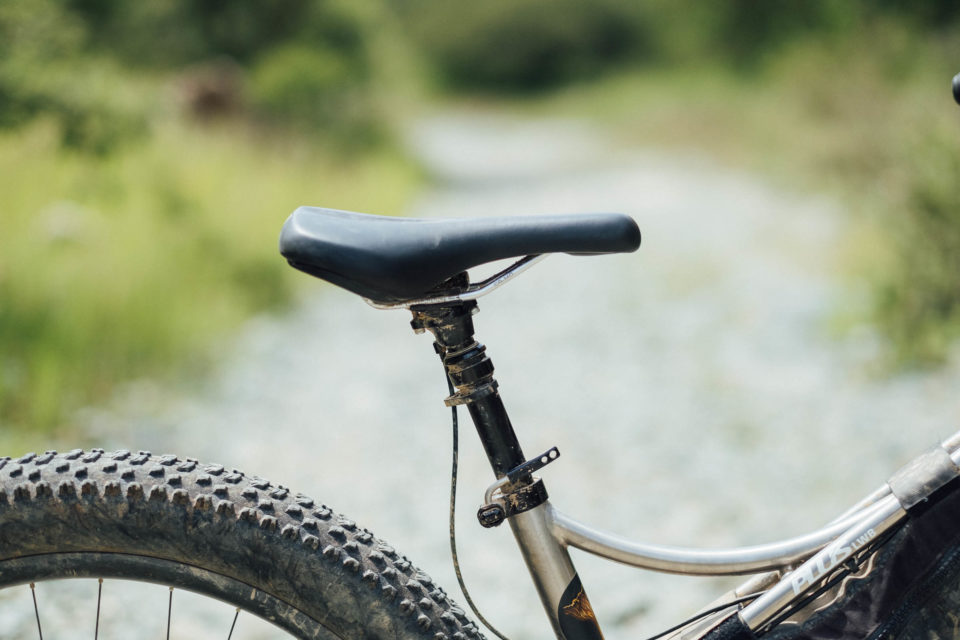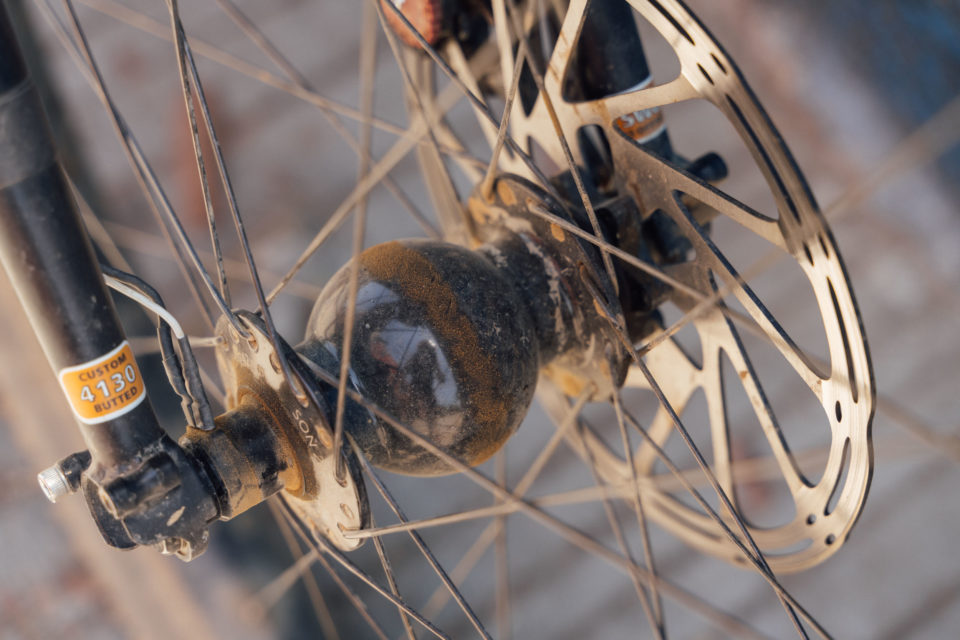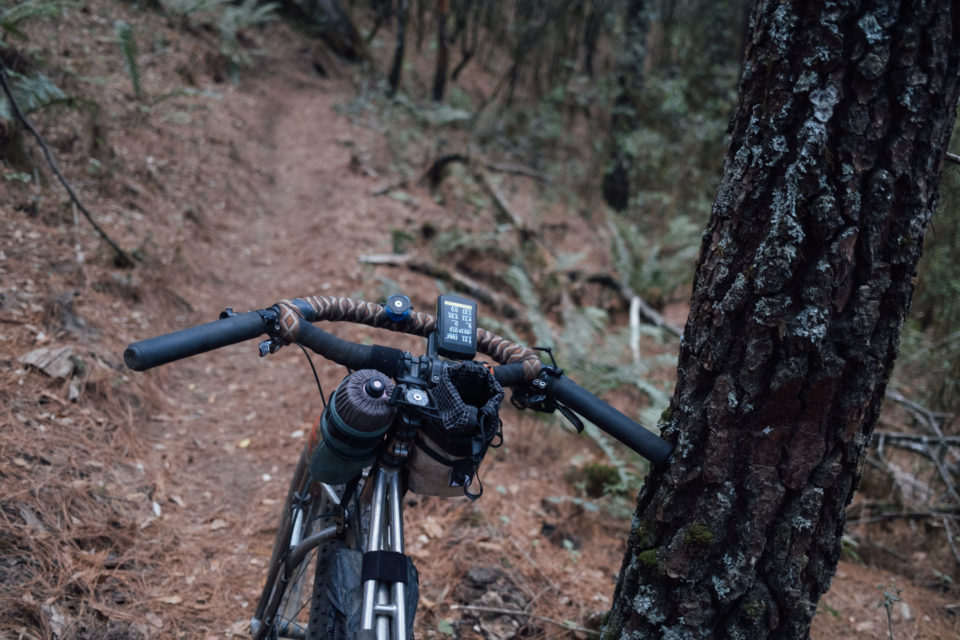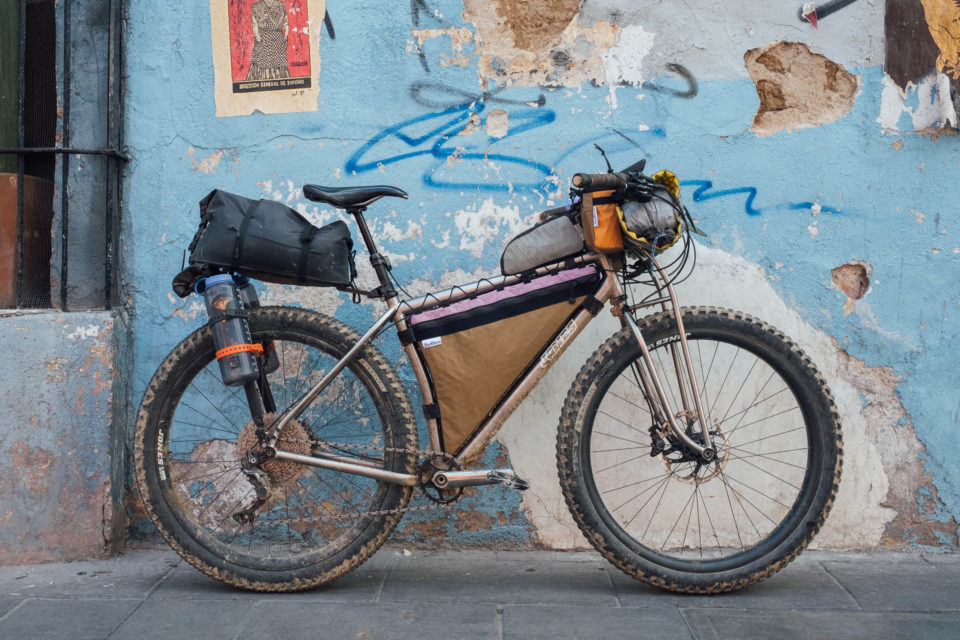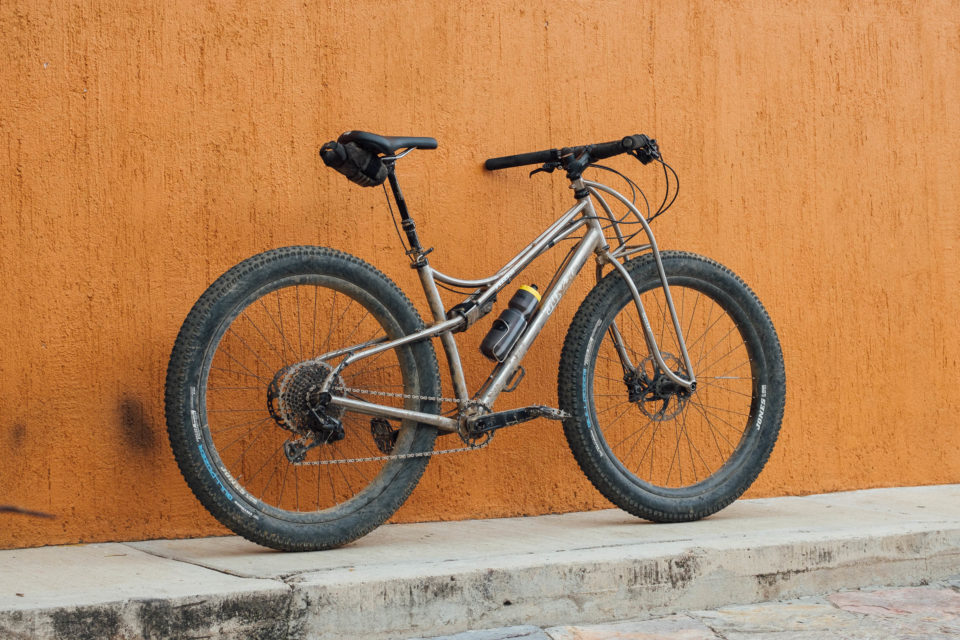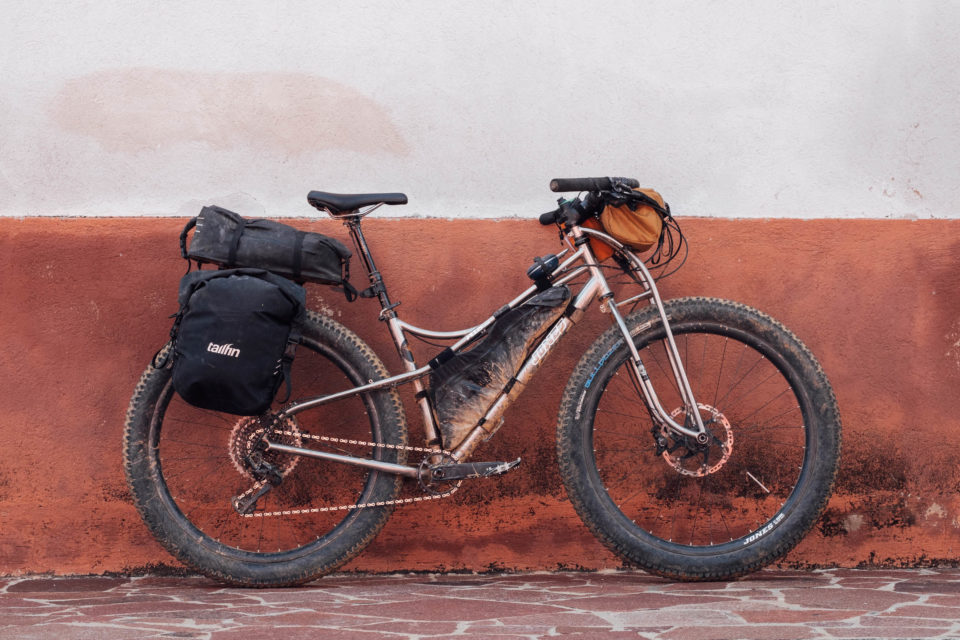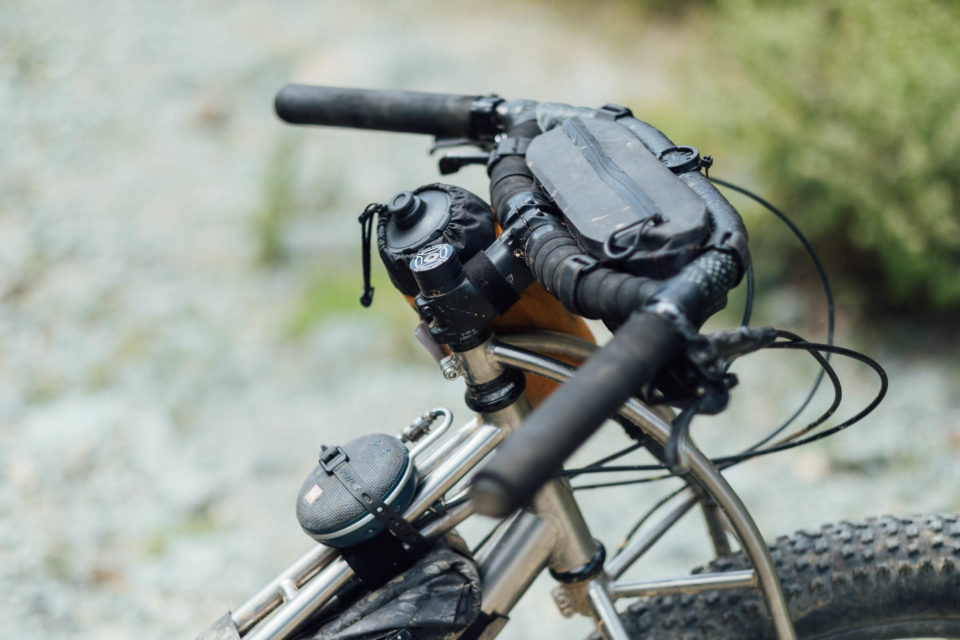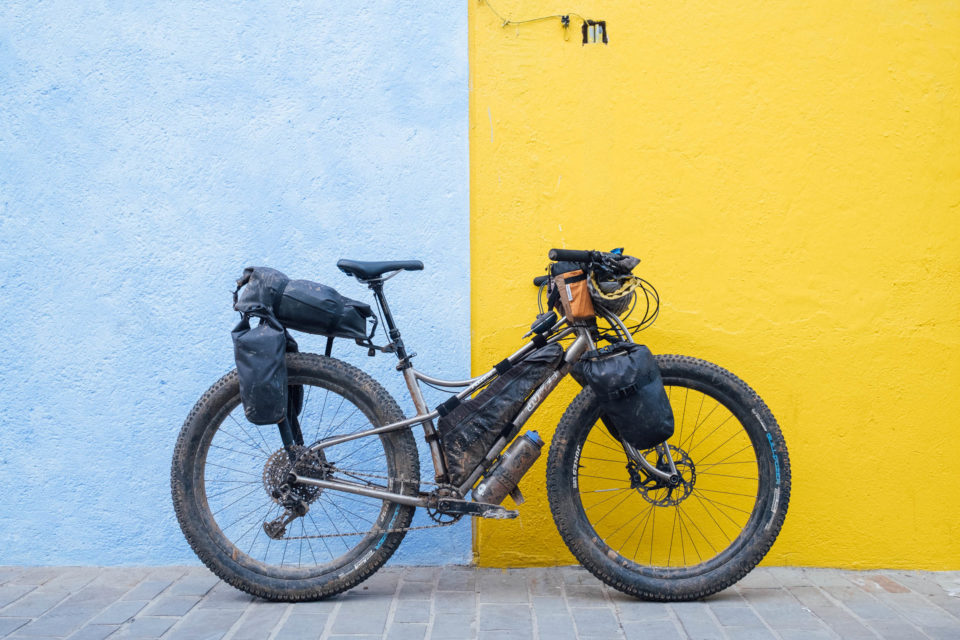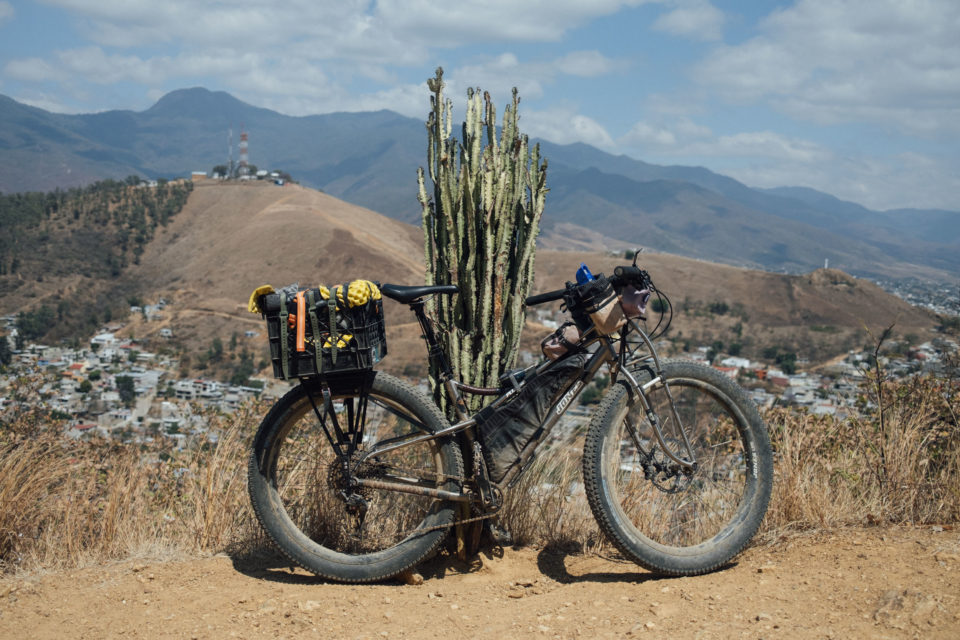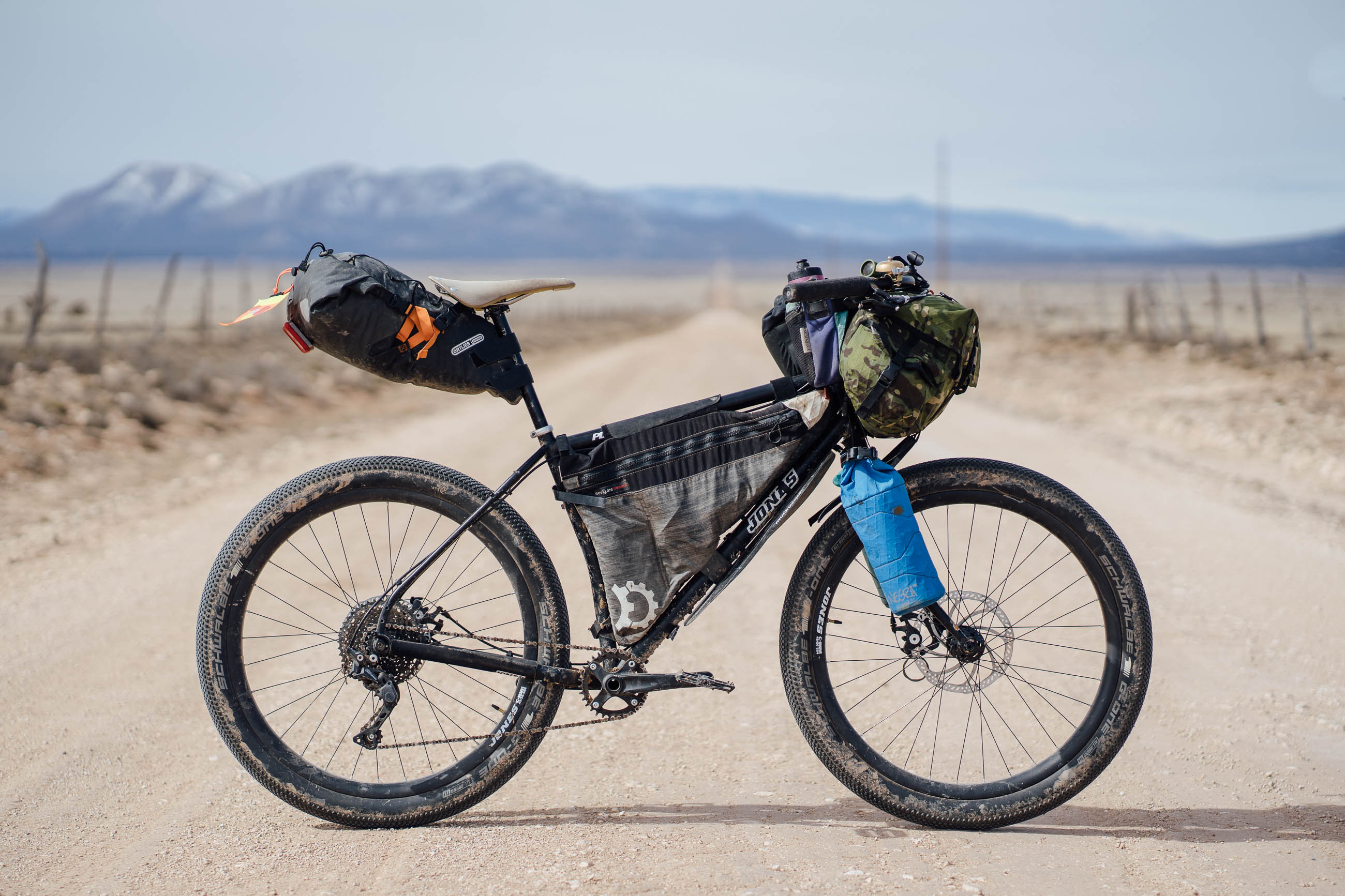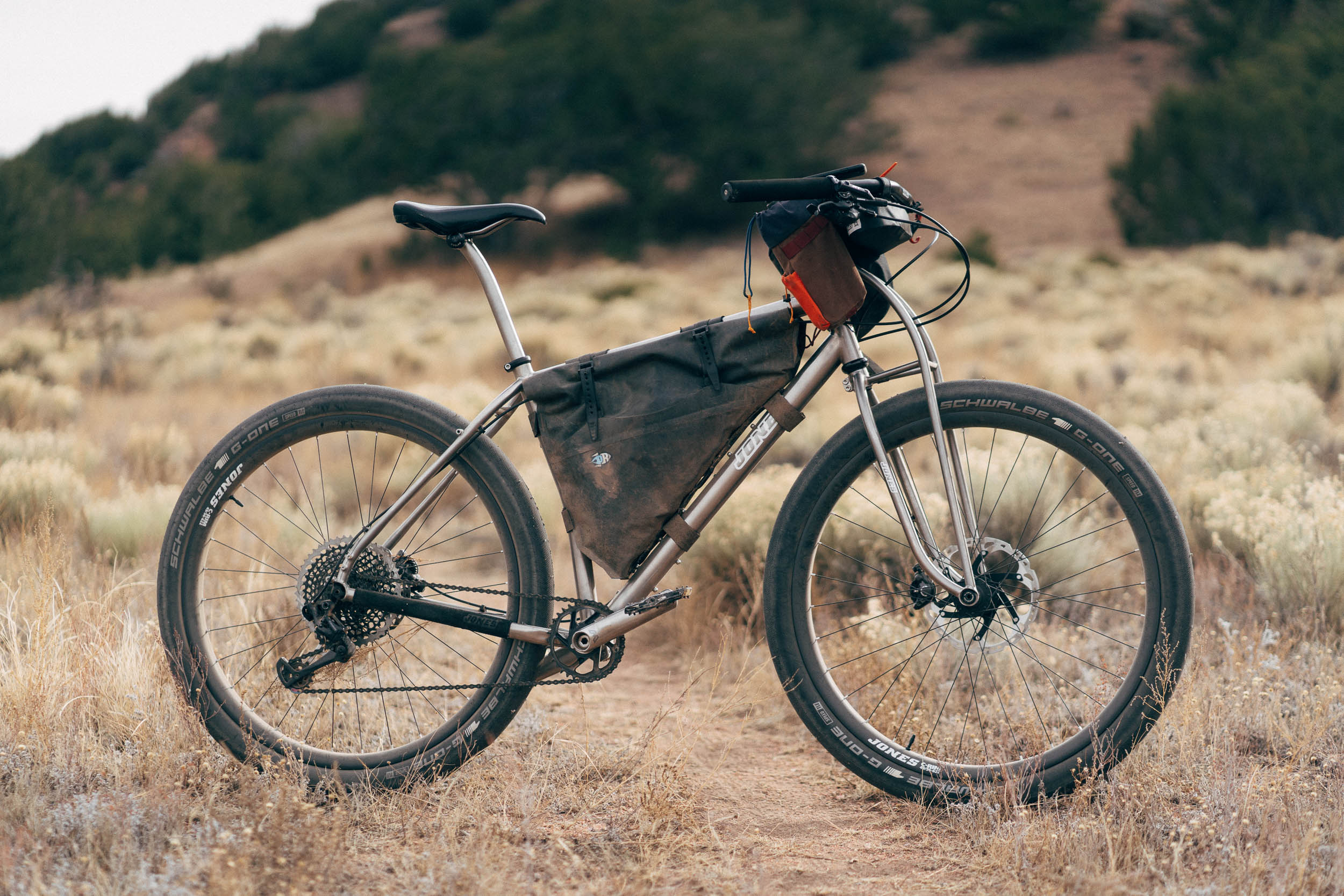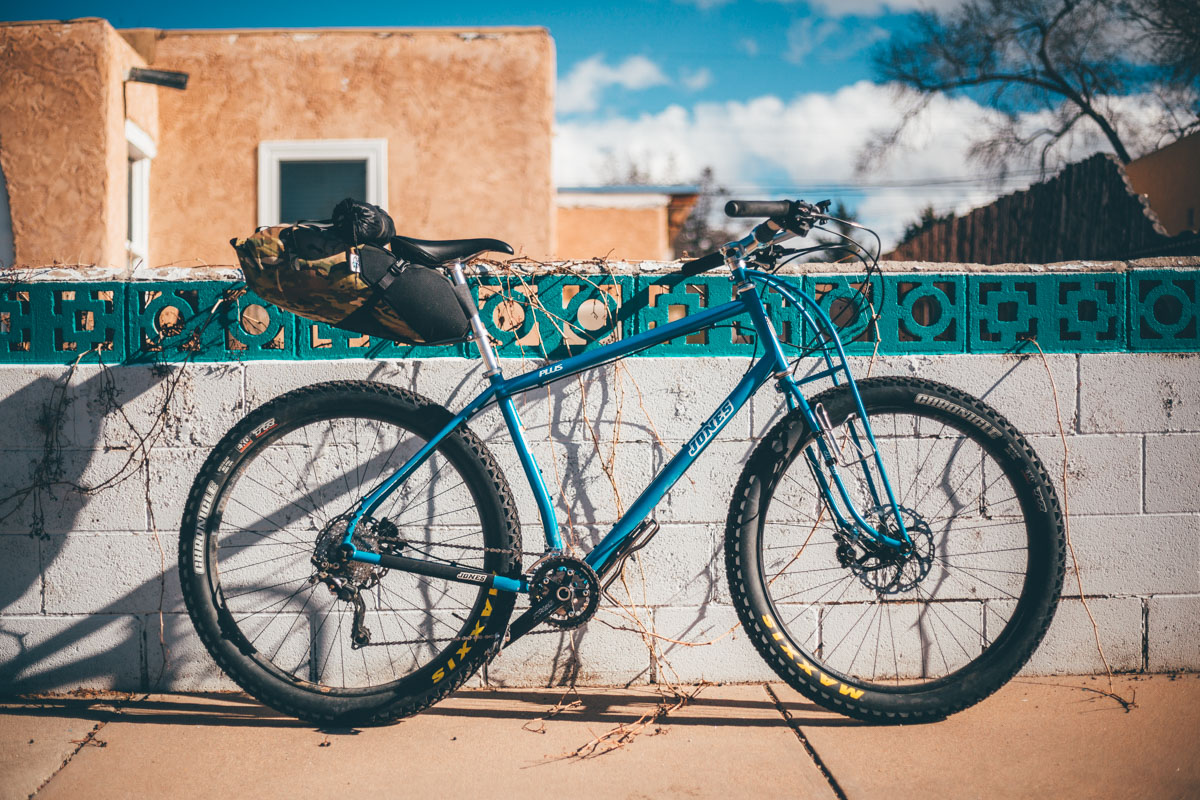Jones Titanium Plus LWB Spaceframe Review: Magic Carpet Ride
Share This
Coinciding with Jones Bicycles’ 20th Anniversary, Cass knuckles down to write a long-term review of his dream bike, the Jones Titanium Plus LWB Spaceframe. After months of daily use, technical singletrack climbs, enduro trail descents, multi-day bikepacking trips, and trailer pulling, he attempts to explain why the latest iteration of Jones’s iconic mountain bike is as special as it’s always been…
Last week, Jones Bicycles celebrated its 20th anniversary. I’ve owned a Jones for six years and have had this Jones Titanium Plus LWB Spaceframe on loan for well over six months, so now seems like a good time to transcribe my opus of notetaking into a more coherent form. After all, this is the bike that represents the culmination of Jeff Jones’ vision for the ‘ultimate’ mountain bike, thanks to its considered interplay between frame geometry and design, fork offset, rim width, and tyre size.
In fact, the image below shows an early rendition with a 26-inch wheelset from 2002 beside the current LWB Plus Spaceframe, as available 2022 – revealing how the bike has changed over the two decades. Jeff Jones puts it like this: “The first Spaceframe was me trying out ideas to make a bike that would ride better for me, such as a slacker than normal seat tube and head tube angle, more fork offset, shorter reach, and curved tubes for vertical flex. I made the truss fork for the first time here because it seemed like the best way to build a light, strong, and stiff fork.
My current bike still has many of the same design ideas. It now has even slacker seat tube and head tube angles, more fork offset, and a shorter reach than the original bike. The curved tubes remain for vertical flex, but the truss fork now has two front tubes bracing the fork, and the H-Bar Loop also offers more hand positions. The wheels are now much larger, and the wheelbase is longer with adjusted geometry. I’ve always used the biggest wheels and tires I can get at the time.”

I’m a vocal fan of the Jeff Jones school of bike design, considering it to be a prime example of a versatile, modern-day ATB, that’s capable of almost anything. I purchased my Jones Plus with a steel diamond frame and a Ti truss fork shortly after reviewing it in 2016, and since then, I’ve enjoyed working my way through much of the Jones fleet, including both the more budget-orientated Jones SWB Plus Complete and its high-end titanium brethren. You can find these reviews linked below.
- Highlights
- Angles (Medium): 67.5° Head tube, 71° Seat tube
- Chainstay: 482mm
- Fork rake: 76mm
- Bottom Bracket: 68mm BSA threaded
- Bottom bracket drop: 76-88mm
- Wheelbase 1175mm
- Hub specs: 15 x 150mm front / 12 x 148mm rear
- Seatpost Diameter: 27.2mm
- Tyre size: 29 x 2.6″ to 29 x 3.25″
- Price (frameset): $4,750
This, however, is the first time I’ve had the opportunity to try the fabled Jones Spaceframe, even if the geometry is actually the exact same as its less glamorous diamond-frame and unicrown fork equivalent. It arrived with me as a frameset, to which I added an existing set of wheels and a collection of parts that I already owned. Over the last months, it’s been my daily ride; I’ve taken it on my local trails, for multi-day bikepacking, extended dirt road loops, and even trailer-hauling and cratepacking with Huesos, Mexico’s smiliest dog (I know, I’m biased).

The Jones Spaceframe & Truss Fork
Where once they were crafted in the US, Jones Spaceframes and truss forks are now made in Taiwan by a framebuilder noted within the bike industry for the high quality of their workmanship (just as Jeff Jones is known for his exacting requirements, regardless of cost). Despite its elegant profile of gently curving tubes, the design of the Spaceframe is less about looks and more about vertical compliance and increased standover clearance – and while there are certainly other forces at play when it comes to its deconstructing its sublime ride quality, I did feel a subtle but discernable difference over the titanium diamond frame I’ve also tried.
If you’re settled on titanium but deciding between the two frame styles, I’d even suggest that a Spaceframe makes greater sense, in that the shapes of its tubes are better suited to bringing out its inherent ride qualities, whilst only incurring a relatively small weight increase (168g) and price upcharge ($200) despite all the extra material and workmanship.
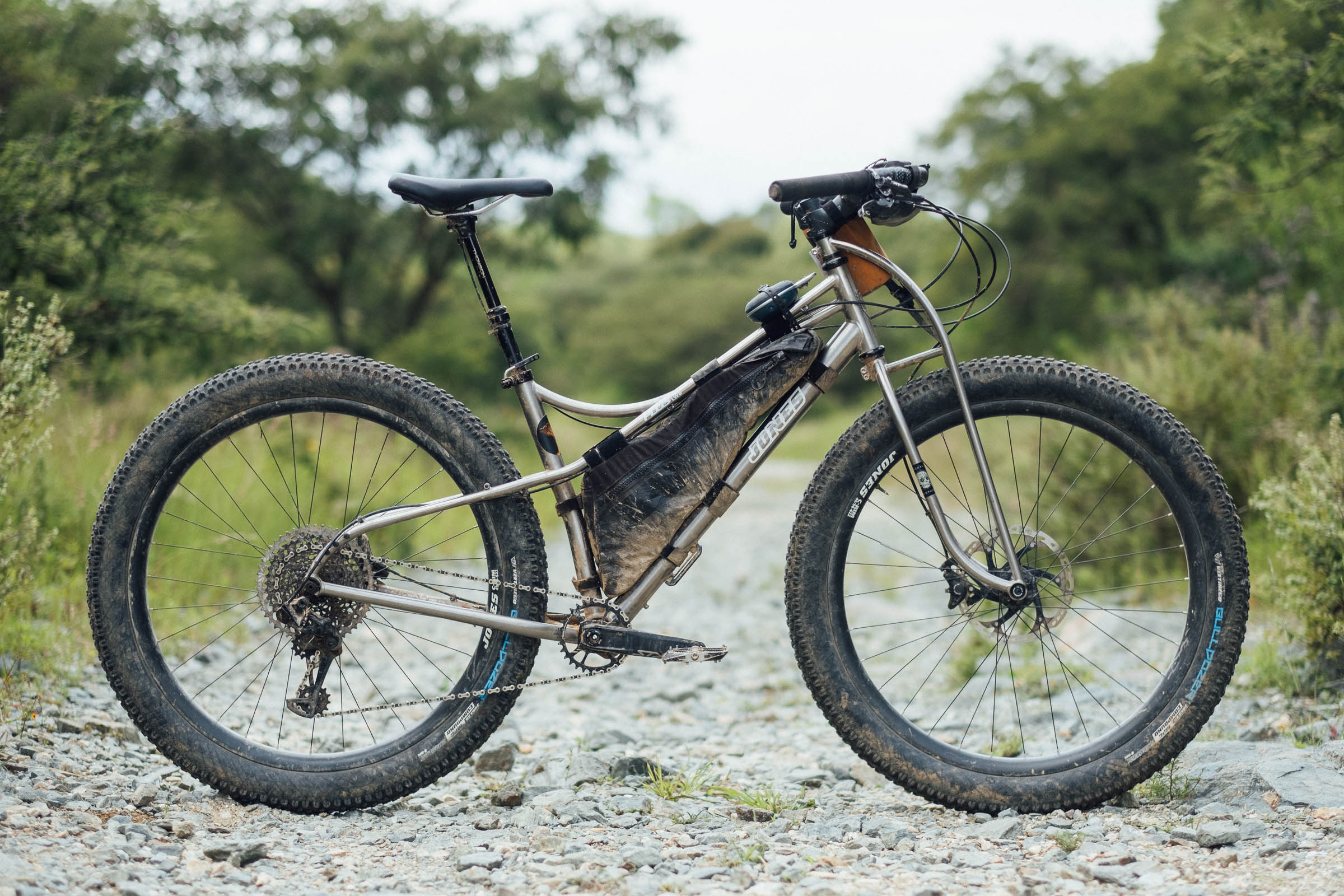
Torsional rigidity is meant to be preserved within the Spaceframe design, though it felt to me like it was more prone to ‘waggling’ when I overloaded it at the back, be it with heavy panniers, or a rack, milk crate, and a dog on top! Framebag space is clearly more limited too, though the twin top tubes provide a stable platform to lash on extra gear if need be. Whilst the fit of the Jones-branded Revelate framebag is a little off (it’s the exact same bag across all the frame sizes), it’s wide, well-made, and offers a very usable space to stash tools and food.
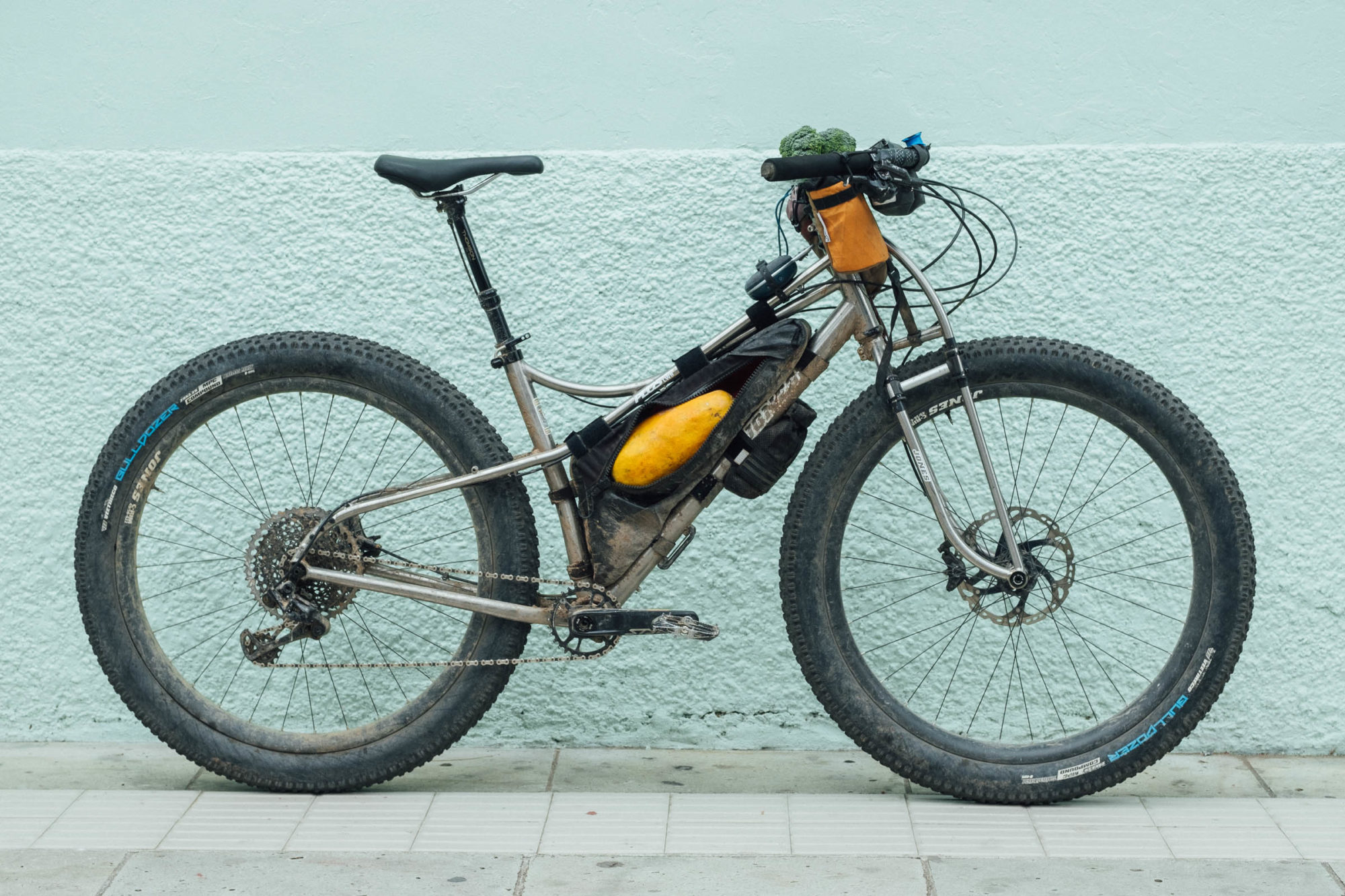
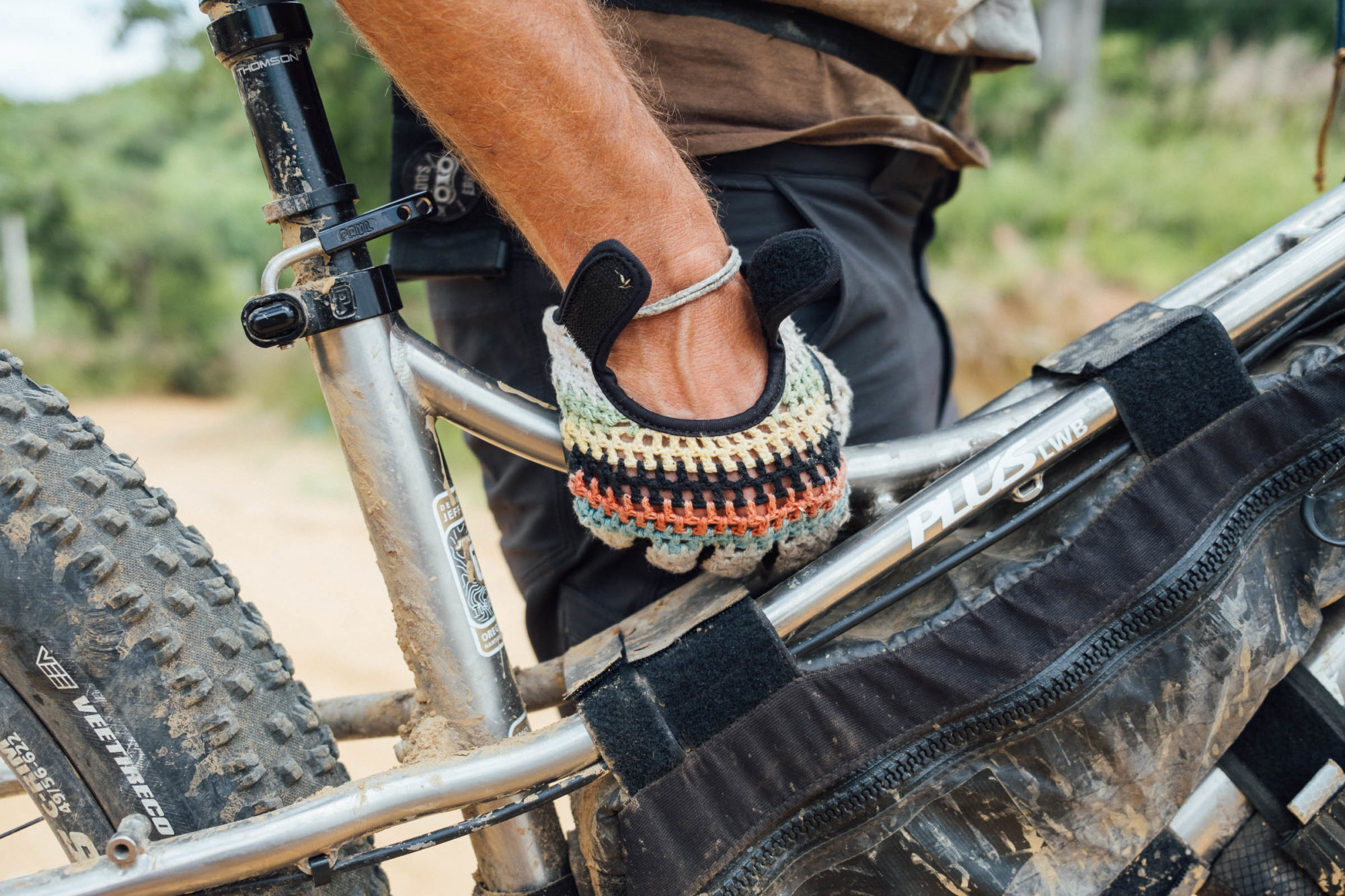
Like other frames within the Jones ‘custom select’ range, there’s an eccentric bottom bracket that offers 12mm of adjustment in bottom bracket height, allowing you to fine-tune its position according to your riding style and tyre choice. Singlespeeders and Rohloff enthusiasts can rejoice too, as the eccentric shell can also be employed to tension a chain. I did hear it creak at times, quietening it with a clean and a dab of grease. More particular to the shape of the Spaceframe. I occasionally clipped my size 45 shoes on the seatstays, and although I love the look of the frameset, there’s a little too much in the way of Jones branding for my tastes – a simple decal across the downtube would be enough for me, given the bikes already iconic profile.
Elsewhere, there are triple eyelets above and below the downtube, though nothing on the seat tube due to its bend. The frame also includes a set of four eyelets above its Boost-spaced dropout. I presume this is to fine-tune the height of a rear rack, though their spacing will also accept a water bottle cage too, which could be handy for a desert journey like the Baja Divide. Tyre clearances are massive all round. The rear will accept 29 x 3.25″ rubber with room to spare – the likelihood of chain rub on the tyre sidewalls will be the issue when it comes to mud, as it runs close with a 1 x drivetrain.
The truss fork, designed to be considerably lighter and more precise than a unicrown fork, sports a 150mm thru axle and will even fit a 26 x 4.3″ tyre for those who really like to experiment with front end comfort and traction. Jones also offers Revelate-made Truss fork packs, which I’ve reviewed here, though I’ve been running Tailfin’s 5 and 10L Mini Panniers, with a prototype, 3D-printed ‘truss strut’.
Jones Geometry
Although the LWB’s geo numbers do begin to make sense once you’ve actually ridden one, they’re unconventional enough that it’s probably best not to get overly lost in the geometry chart weeds for now, or get caught up in any specific numerical differences to what you’re used to riding. Broadly speaking, the LWB platform is noted for its long wheelbase (as the name suggests), its massive fork offset (compared to other mountain bikes on the market), low bottom bracket (though this is teamed with shorter-than-normal cranks), and its short reach (especially when lined up against bikes of a similar size). I’d recommend diving into this fascinating discussion from six years ago, where Jeff Jones explains where this geometry came from – you’ll see that he even made a prototype that was longer still before ultimately dialing the numbers back in.
Working holistically with the frameset is the equally distinctive Jones H-Bar. The somewhat extreme 45-degree sweep, in conjunction with the frame’s short reach, allows a rider’s hands to slide forwards or backwards along 205mm grips – where you place them will depend on both the nature of the terrain, be it up or down, and the vagaries of a headwind.
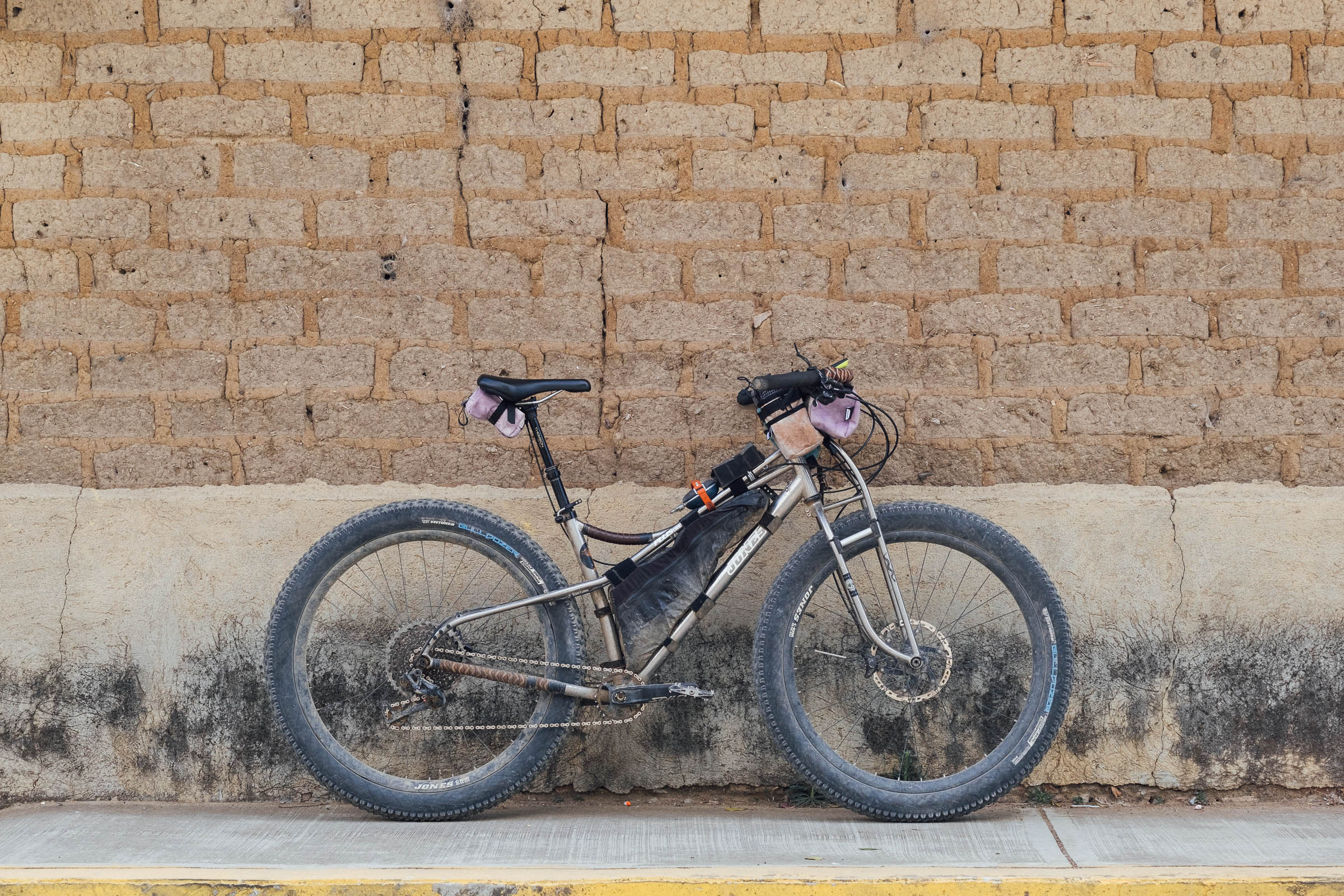
The net result is a heady mix that gives the LWB its unique character: it’s a bike with a supremely comfortable and upright riding position, a surprisingly light and lively front end, and a ride that’s also extremely stable on the chunkiest of descents. In fact, the LWB imbues confidence on even the steepest terrain, largely because the front wheel is kicked out so far enough in front of you, there’s little fear you might be tipped you over the handlebars!
The Ride
When I took the Spaceframe out for its inaugural first ride around the block, after a late night building session in the confines of my apartment, I was immediately blown away by its ride quality. As I scoped out the roughest sections of cobbled streets I could find, I had the sublime sense of floating on a magic carpet.
This smoothness likely emanates from various factors working together towards a common cause, be it the vertical compliance in the Spaceframe itself, or the increased fork offset that dampens vibration through the hands. I’m sure the upright riding position plays its part here too – I have the sense that my legs can absorb trail shock, rather than it being transmitted through my hands and back. The bike’s extended wheelbase definitely smooths out the chunk, something that I noticed when jumping between the SWB and LWB (see box out below). Initially I was running a Ti seatpost too; at 27.2mm in width and with considerable post exposed, there’s comfort to be gained there too. And then there’s those big, 29+ wheels. Wide, tubeless-ready carbon rims allow low tyre pressures to be run safely, without any sense of disconcerting tyre roll. For my use cases, weight, and riding style, I was able to lower pressures down to 7-10psi on 29 x 3.25″ tyres, which is far less than I’d normally go.
The riding position suits me too. I’m upright, my back isn’t hunched, and I can enjoy the glorious views – but I can also move up and down the bars if I need, for a more efficient, aero position. In fact, I made very few setup changes, except for adjusting the angle of the bars. There’s no need to work your way through an assortment of different handlebars as everyhing falls under the hands exactly as it should – in fact, I don’t know of any Jones bike riders who don’t run these handlebars too, beyond the odd experiment.
As importantly as comfort, the bike is a complete joy to ride. Despite its size, the LWB Spaceframe is springy and encourages me to launch off rocks. Its lively steering helps me flicks through trees, and coaxes me into riding faster. It’s extended wheelbase somehow shrinks down in size on tight switchbacks, and its low bottom bracket helps to carve around corners. Climbing is another area where it surprises. Whilst modern, long, low and slack hardtails have moved towards steeper seat angles to help prevent front wheel loft, the LWB uses 482mm stays and a 76mm fork offset to keep the front end tacked to the ground.
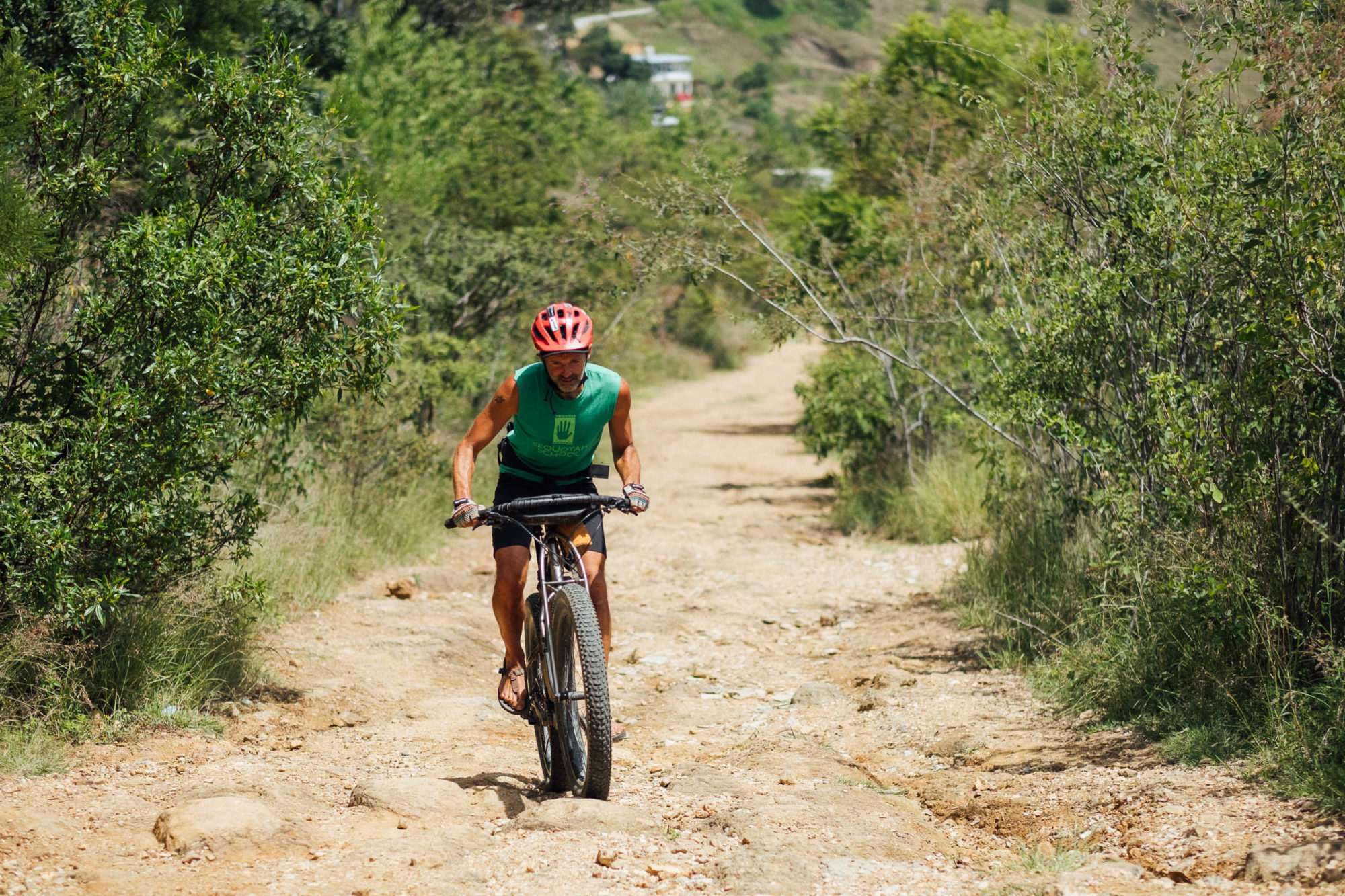
I found myself climbing steep, technical terrain more proficiently than on other bikes I’ve ridden, including Jones’ own SWB, with less of a need to ride on the tip of the saddle, or lower my chin to the handlebars – whether I’m sitting or standing. As a counterpoint, it does mean that this bike is harder to loft than bikes with short chain stays, but for the riding I like most, this is a worthwhile trade-off.

3in tyres are an important part of the fully rigid ride recipe, but what if you can’t find them? Certainly, they’re impossible to buy in Mexico so as an experiment, swapped them out for 29 x 2.6″ rubber, which is much more readily available – I opted for Specialized Butchers, which I can definitely recommend, not least because they set up tubeless so easily. I adjusted to bottom bracket to its upper position and on the same wide rims, pedal strikes weren’t an issue. The bike might even have been more playful but what I did notice, however, was a penalty in riding comfort on chunky trails, especially at speed.
For now, my compromise is to a 29 x 3.25″ Vee Tire Bulldozer up front, to maximise traction and comfort, and a 29 x 2.6″ at the back, given that I wear out rear tyres more quickly. Still, although vailability of 29+ tyres models may have decreased over the last few years, I’m confident that will always be a handful of decent options to choose from. For now, it seems like Bontrager’s SE4 and Maxxis’ DHRIIs and Minions are the way to go aggressive trail riding, or WTB’s Ranger for more loamy conditions and forest road bikepacking. Either way, it’s reassuring to know that 2.6″ tyres are definitely a viable tire size on the LWB, should you damage your 3″ tyre on tour.

This desire to create a ‘complete’ mountain bike from the ground up, in which frame, fork, wheels, and components are designed to work in tandem with each other, does demand an important compromise, if we’re to call it that. The LWB is rigid specific, along with all Jones bikes, which can take its toll on more demanding trails, especially when ridden at high speed. Now that ‘mountain biking’ has fractured into a number of disciplines – and even cross country trails have become steeper and more technical – chances are you’ll need to take different lines, and likely ride at a slower pace, than your hardcore enduro bike buddies (even if I’m always surprising these same friends with what I can condidently ride). More skillful riders will probably bridge this gap better – take a look at the video linked below and you’ll see that in the right hands, the LWB is capable of a lot. Simply put, don’t be deceived by its looks: with the addition of a dropper post, this is an extremely capable mountain bike, just one that you’ll need to ride a little differently.
Minor Frustrations
And about that dropper post. All Jones frames also run 27.2mm seatposts. Although a 27.2mm seatpost – especially in titanium or carbon – and a narrow seat tube can add considerably to the overall comfort of a bike, it is limiting when it comes to dropper posts. Like many, I’ve grown to find them indispensable for trail riding, especially here in Oaxaca where there’s a big enduro scene. Unfortunately this narrow seat post diameter limits me to just a few models, all of which are short by today’s standards. As a solution, I run a Paul Components quick release seat post collar for those occasions where I need to drop my saddle lower still – but it definitely detracts from the on-the-fly adjustment that makes droppers so appealing in the first place.
Furthermore, there’s no internal routing option on the frame. Whilst an external dropper is actually my preference for the way I use this bike, as it allows me to quickly and easily change from a rigid seat post (dirt road touring) to a dropper (trail riding and singletrack bikepacking), it also diminishes options still further. As it is, there’s either the expensive Thomson Elite (125mm travel), the KS Lev (120mm travel) or the more affordable but shorter travel PNW Pine/Tranz-X Kitsuma (110m travel) to choose from. It’s not a deal breaker for me, but it’s definitely a shortcoming that I’m aware of on the more technical trails here.
There is another Jones quirk I’ll mention too – that 150mm TA front end that I’ve grumbled about before! I certainly appreciate that a wide, thru axle fork spacing allows for an incredibly strong front wheel (and if we’re to talk Jones history, 150mm TA is an improvement over the prior 142mm TA Jones-specific hubs), there are times that I still wish these bikes featured Boost standards throughout. It would take some of the headache out of sourcing a replacement front wheel in the event of a failure or crash, and opens up options for more affordable dynamos or secondary wheelsets. But then I remind myself that it wouldn’t be a bike designed by Jeff Jones if it compromised on his beliefs.
All is forgiven
Luckily, I only have to head out on my daily loop for these frustrations to quickly evaporate into the ether, replaced by my appreciation at what what joy it is to ride. I’m upright enough to look around and enjoy my surroundings, yet with a slide for or aft along the handlebars, I can negotiate steep and rocky descents with confidence and safety. For 95% of the time I spend on a bike, the LWB platform strikes a perfect balance between comfort, enjoyment, and performance. It’s only when the trail gets especially steep and feature-laden that I feel like I’m underbiking. I’ll just dial back my speed, as there’s rarely much I can’t ride more slowly.
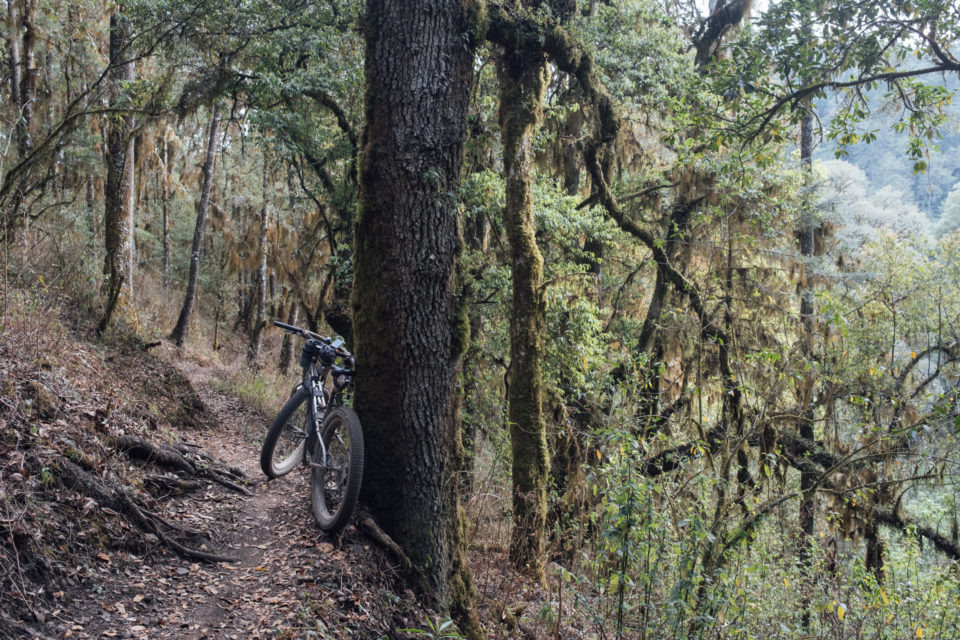
Jones LWB vs Jones SWB
This is a question that comes up a lot, so before finalising the review, I moved the wheelset over to the SWB – whose contact points are set up to be identical to the LWB – for a refresher.
I immediately noticed that the SWB isn’t as proficient a climber as the LWB on technical singletrack, nor is it as comfortable over rough terrain. It is, however, more nimble through tight forest singletrack and easier to loft the front end. Interestingly, I found myself cleaning rutted out, twisting descents more easily, but with less assurance and satisfaction. The LWB is able to straightline more proficiently on steep downhills, so as a result I ride more quickly and I feel safer. I also prefer it for drops and rolls, for similar reasons.
Both will accommodate a variety of wheel sizes, though the LWB errs towards larger volume 29er rubber. I’ve run the SWB with 27.5 x 2.8″ G One All Rounds, and it’s as close to a fast and comfortable ‘gravel’ bike as I can imagine wanting, and I’ve also set it up 29 x 2.35″ G One Speeds, which turns it into a fun ‘all road’ bike. The SWB is also more compact when it comes to boxing or bagging up for travel – I’m not sure if I could get the LWB to fit in my favourite Ground Effect Tardis – and it’s a touch lighter too.
Nevertheless, if I had to choose between the two, it would be the LWB that I’d opt for. I find it the better bike for the kind of trails I enjoy riding most, specially here in Oaxaca, where the terrain is chunky and that extra fork offset can be put to good use. For one reason or another, it has a dollop more of the Jones ‘secret sauce’ that I like so much.
Sizing
Due to Jones’ unconventional geometries, sizing often causes confusion, especially as there are only three to choose from – and considerable overlap in between. The diamond-frame Jones that I originally bought is a size Large, which I chose because I wanted to run the biggest framebag I could. Jeff Jones felt I’d have been better off sizing down, so for this review I gave a Medium a chance. This was in part because there’s almost no difference in framebag size between the S, M, and L Spaceframes, so I wouldn’t be losing out on valuable storage capacity.
Some observations: for trail riding, the size Medium is a blast to ride and with a slightly longer stem, the reach is the same as I have on my own bike. It’s a touch more agile, but the size Large is certainly no slouch. Both are sufficiently upright to enjoy the views.
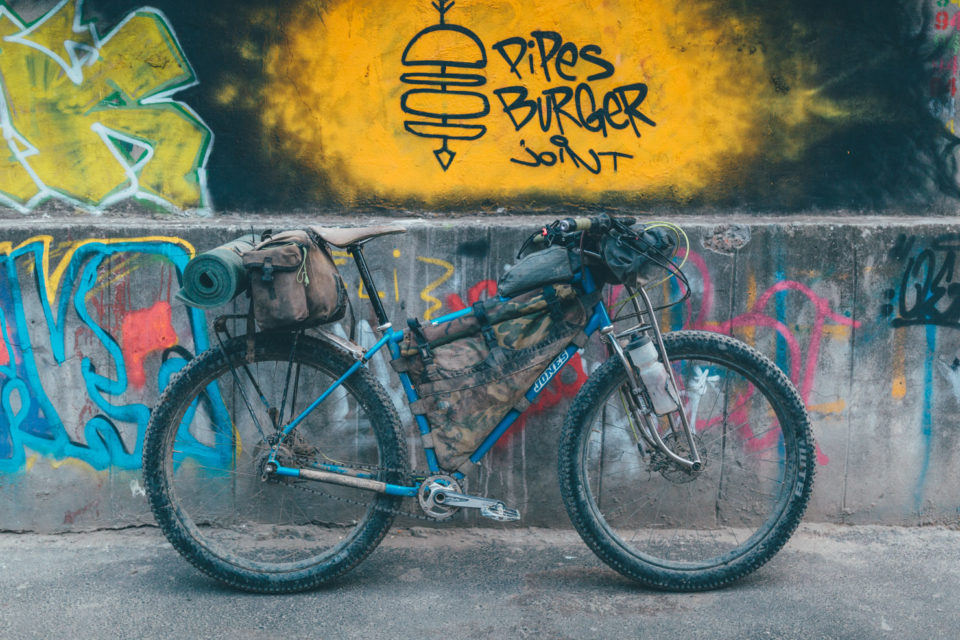
Granted there are other variables (saddle rail height, choice of pedals, shoes, and EBB position) but for me, the main disadvantage of the Medium frame is that I’m just beyond the minimum insertion point for some dropper posts, which suggests I’m at its limit. I’m just under 6’1” (184.5cm) and I have a I have a PBH of 91.4cm.
Now that I’ve spent time with both, I’d have no hesitation in riding either. I love the framebag size on the Large LWB and it offers me a wider choice of dropper posts. But the Medium also feels spot on, and it’s extra lively on trails.
It’s also worth noting that at the other end of the scale, the Spaceframe’s low standover lends itself extremely well to shorter riders. As per the Jones website, a size Small LWB Spaceframe fits riders down to 5′ (152.4cm) in height, and perhaps even less.
Jones Spec
Jones now offer a wide range of relatively wallet-friendly ‘Jones Spec’ parts, as well as curated choice of high end brands. I’ve run the LWB with components that I mostly already owned or moved over from another bike. My handlebar is the carbon H-Bar Loop in a 710mm width. Not only is it light at 275g, it offers lots of hand positions, ample real estate for electronic gadgets, and it should help dampen vibrations too – I team it with Jones’ ultralight EVA H-Grips, rather than the rubbery and heavy (but easy to remove) Kratons. The stem is Jones Spec, 80mm long with a 17 degree rise.

My wheelset is built up with Jones’s C-Rims (49mm internal width, $660). These carbon rims feature centre and off-centre drilling for an even spoke tension, and mine are laced to DT Swiss hubs, which has proved to be a very light, durable, and serviceable wheelset. If C-Rims are too costly, Jones now have their own 50mm aluminium rims ($85). Both are available in 32H or 36H which is great news for heavier riders, and can be specced with Presta or Schraeder tubeless valves.
Given the outside diameter of 29+ tyres and the unforgiving nature of the climbs here, I’m running a SRAM GX cranket with a 28T chainring and a 10-50T cassette. Jones recommends shorter cranks than you might expect for your height – mine are 170mm – which helps offset the bike’s bottom bracket drop. Brakes are by Shimano, a mix of XT and Deore calipers and levers that were available to me at my local shop when I built the bike up. I’m running a 200m rotor up front and a 180mm at the back, but would consider a 200m at the back too. I’ve chopped and changed between different seat posts over the months – a basic aluminium one for trailer pulling, a Thomson Elite for trail riding, and even a ti Erikson for maximum bling and weight savings. For what it’s worth, I find the Jones-branded saddle very comfortable, despite its simplicity and low price.
Pros
- Jones geo is a heady mix of both lively steering and stability!
- Upright riding position is very comfortable , though not at the cost of performance.
- 76mm fork offset is very confidence-inspiring on steep descents.
- Spaceframe makes the most of titanium’s inherent ride qualities – more so than a diamond frame – with a relatively small weight penalty.
- Low standover means the frame is suited to a wide variety of rider heights.
- Eccentric bottom bracket opens up a choice of tyre sizes, from 29 x 2.6″ to 3.25″, as well as singlespeed and Rohloff options.
- Truss fork is very light and precise, and can be used to carry cargo in a weight-efficient manner too.
- Long chainstays contribute to climbing prowess.
- This is a Bike For Life as long as parts remain available.
- Ti too pricey? Choose steel, the geo is the same. Lots of build options to suit your budget.
Cons
- Plus tyres aren’t a match for a plush 130mm suspension fork on technical trails. Expect to make different line choices.
- Very expensive frameset, due to cost of titanium and all the elegant tube bending.
- Spaceframe is less suited to heavy loads on a rear rack, compared to diamond frame.
- Truss fork is fiddly to remove if you need to pack the bike into a bag. The whole bike is very long and the hubs are wide, too.
- 150mm TA front hub spacing means you’ll need to go custom for a second wheelset, and dynamo hubs are pricey.
- 27.2mm seat post diameter is limiting for dropper post lengths and options.
- 3″ tyres and 1x drivetrains can create issues in muddy conditions.
- 29 x 3″ tyres aren’t readily available everywhere and are expensive.
- Model and Size Tested Jones Titanium Plus LWB Spaceframe and Truss Fork (M)
- Sizes Available S, M & L
- Frame weight2578g (inc bolts, axle, hanger)
- Fork weight1,114 grams (inc TA, truss bolts, clips, and 345 mm steerer tube)
- Price $4,750 (frameset and fork only)
- Contact Jones Bikes
Wrap Up
I’ll wager that this version of the Spaceframe – the Plus LWB – is the one that Jeff Jones always envisioned making but couldn’t quite realise, in part because the components he wanted weren’t in circulation, and perhaps because the world wasn’t quite ready, too. After all, Jones has always been pushing the envelope for broader rims, larger volume tyres, and wider hubs, but it was only after the sudden growth in popularity of fat and ‘plus’ bikes that off-the-shelf wheel options and different hub standards started to appear.
It should also be pointed out that during this time, riding styles have also changed considerably. Full suspension bikes are better than ever – at both climbing and descending – ushering in the advent of enduro riding and considerably more challenging black diamond trails. And yet, as much as I sometimes hanker for a modern hardtail built for the more extreme descents I sometimes tackle here, and to perhaps to keep up with my friends more easily, I’m constantly reminded how capable, comfortable, and versatile the LWB continues to be. Most importantly, it’s a bike that makes me want to get out and ride, and I only have to hit my local trails, head out on dirt roads, or bikepack in the mountains to fall for its charms once more. In some ways, it harks back to a gentler form of mountain biking that feels more in keep with the environments through which I love to travel.
Ultimately though, one question remains: is all this curvy, titanium goodness really worth such a premium price tag? If you’re already a fan of the brand, you’ll be familiar with Jeff Jones’ tireless quest to create the very best bike he can, and this iteration of the Spaceframe may well represent your dream setup, in terms of ride quality, weight savings, and aesthetics. But I’m certainly not going to try and talk you into spending almost $5,000 on a frame and fork. If you’re unconvinced, I’ll repeat what I’ve said before: in my mind, the Jones Plus LWB geometry is more important than raw materials alone, so I have no hesitation in recommending the steel diamond frame, too. Either way, you’ll be making a sound investment, because by bucking convention and ever-changing trends, these bikes are truly timeless.
Rider’s Background
I’ve been embarking regularly on two-wheeled explorations for over 20 years. I’ve crossed the Republic of Georgia on dirt roads, tackled the Colorado Trail, ridden the UK’s Lakeland 200, and followed the Trans Alps in Europe. Given my love for mountain biking and backcountry touring, my ideal journey fuses the two, keeping to quiet dirt roads and singletrack.
Height: 6’05” (184.5cm)
Weight: 165 lbs (75kg)
Inseam (PBH): 91.4cm
Related Content
Make sure to dig into these related articles for more info...
Please keep the conversation civil, constructive, and inclusive, or your comment will be removed.






